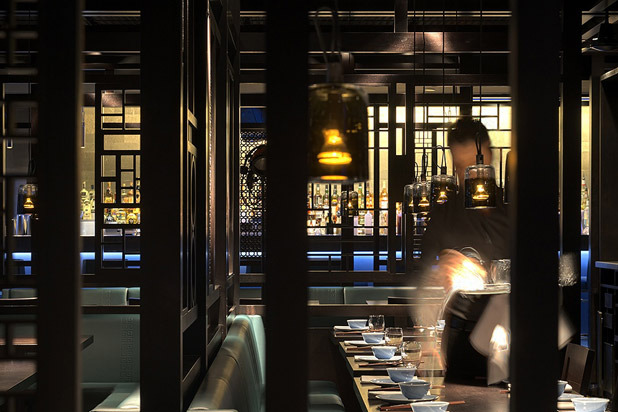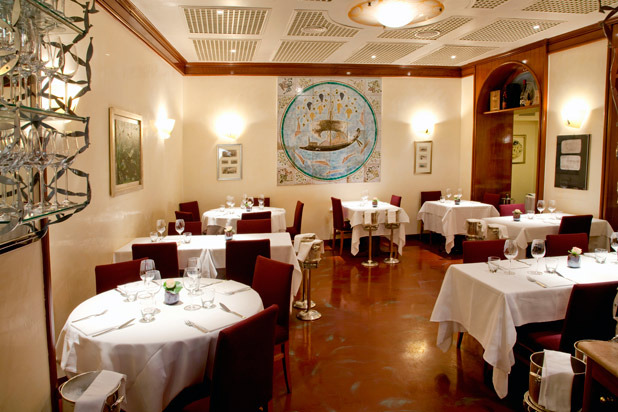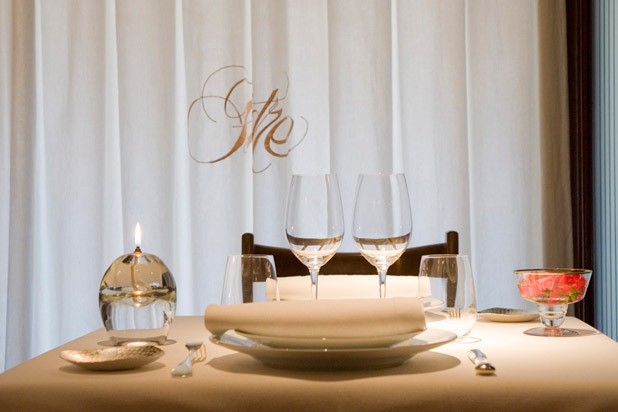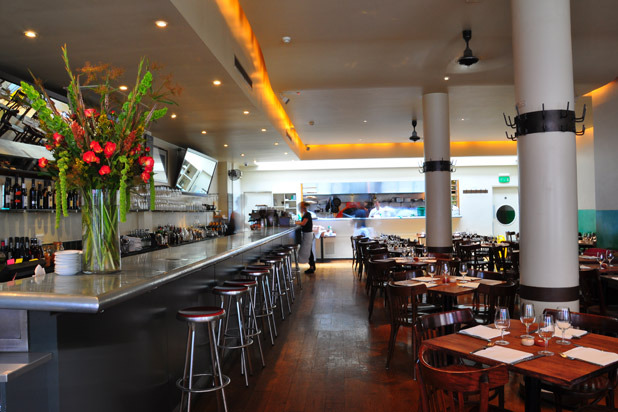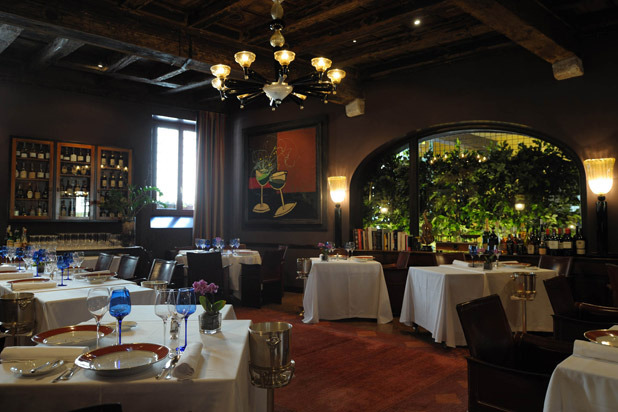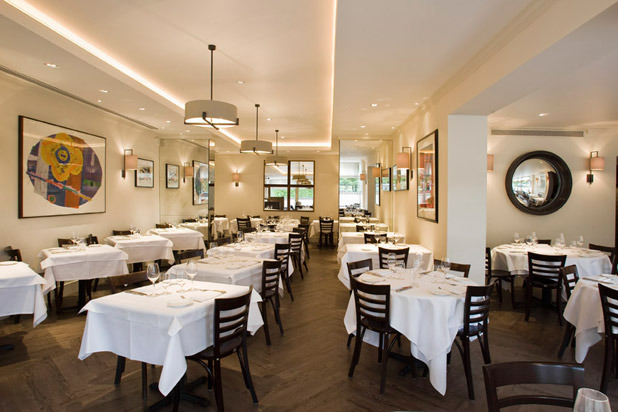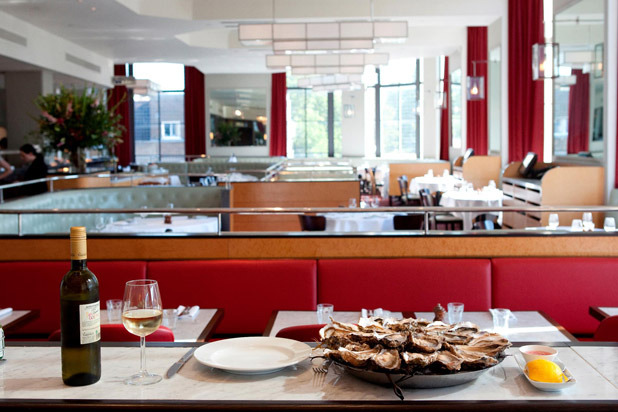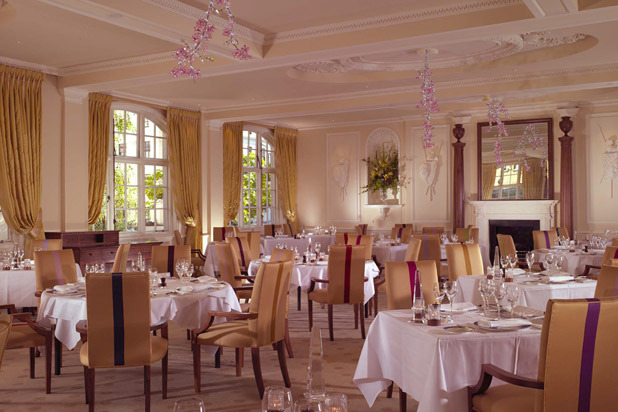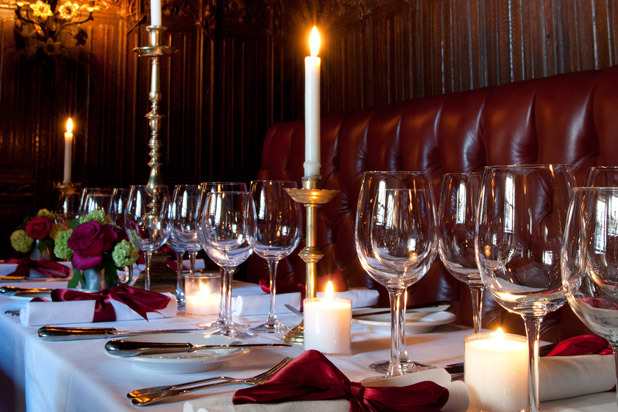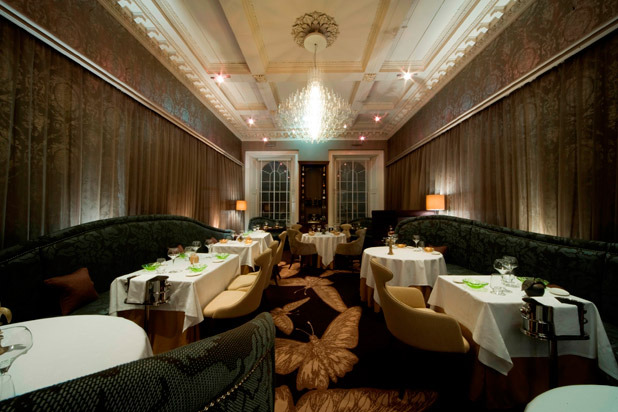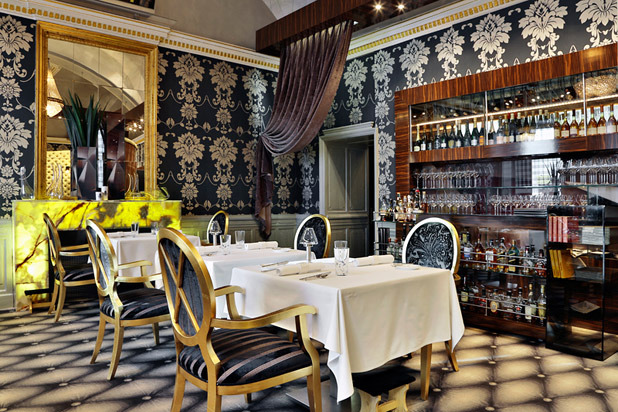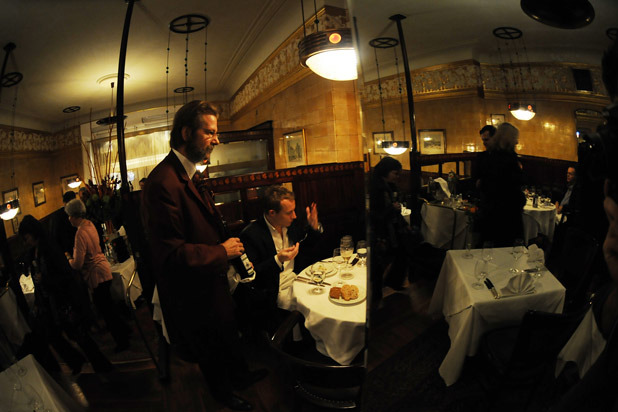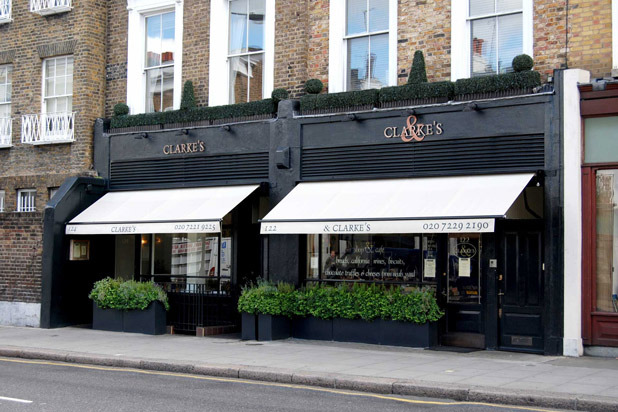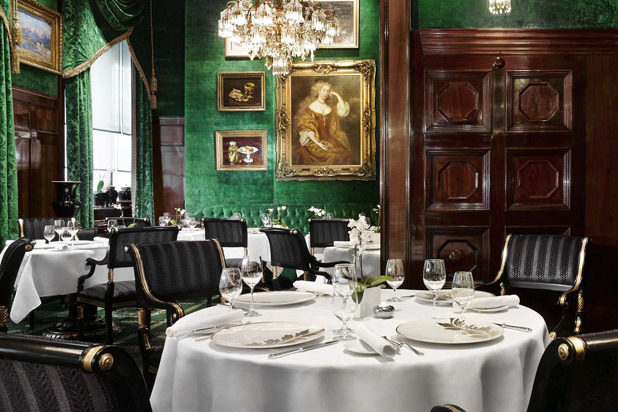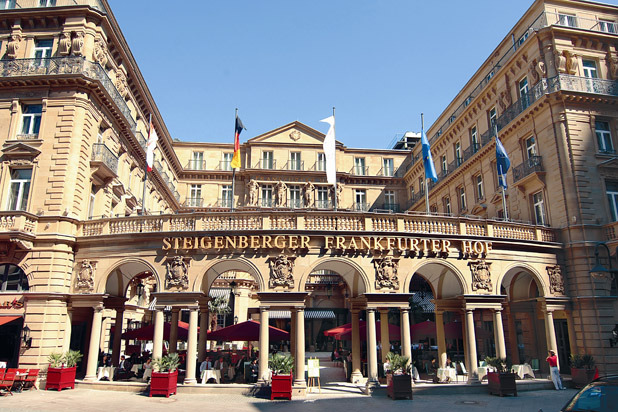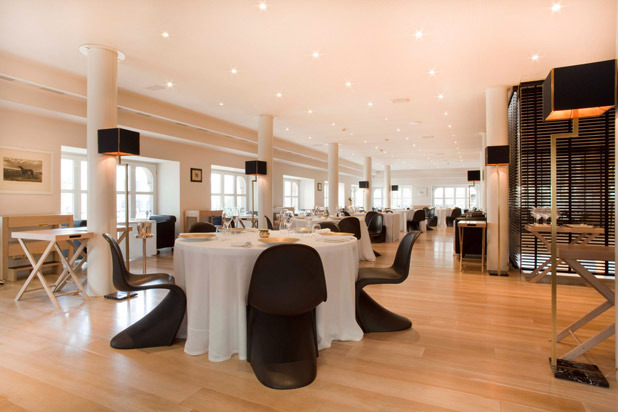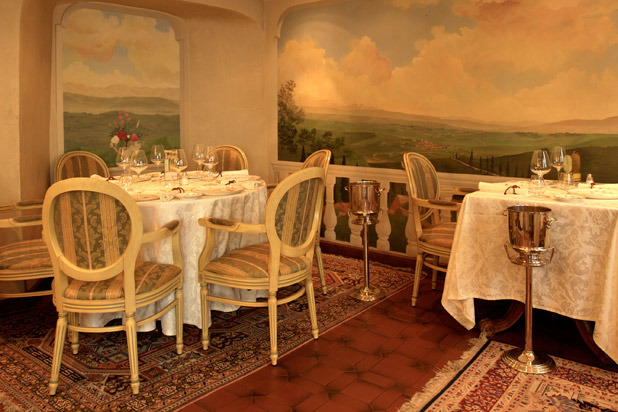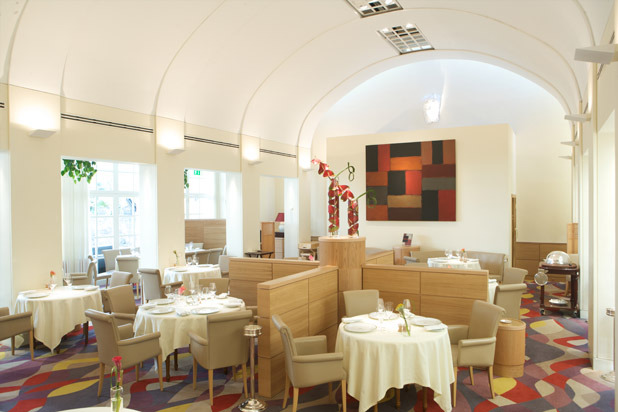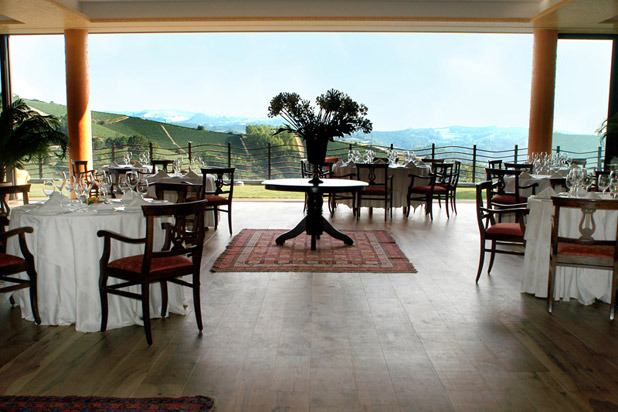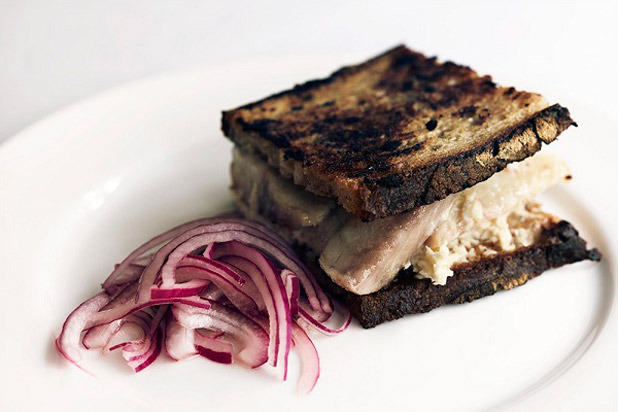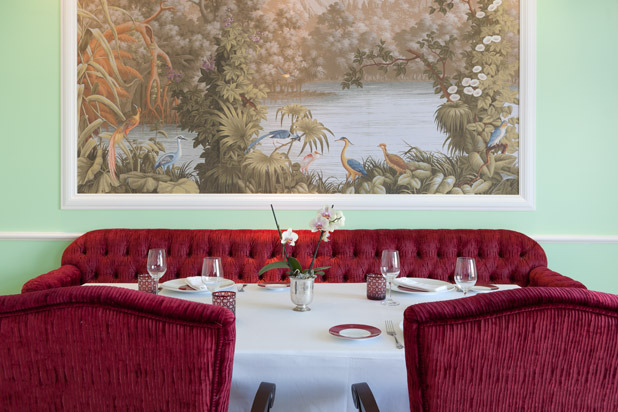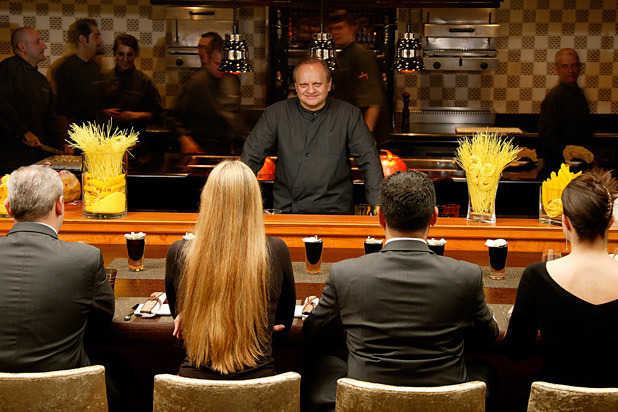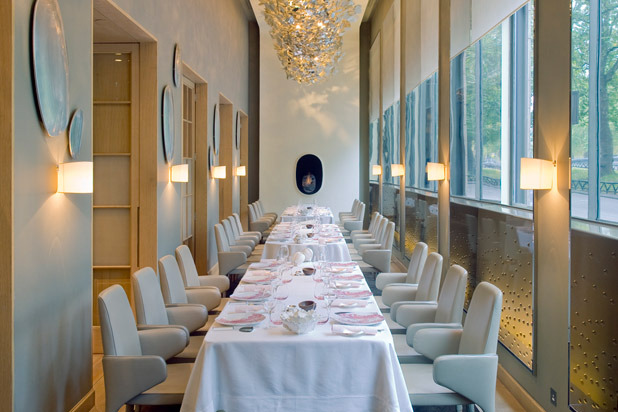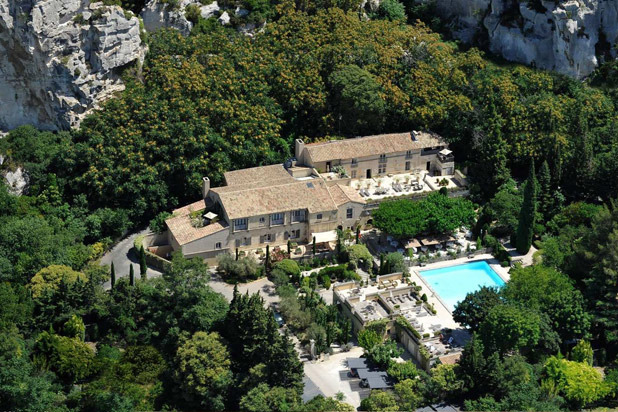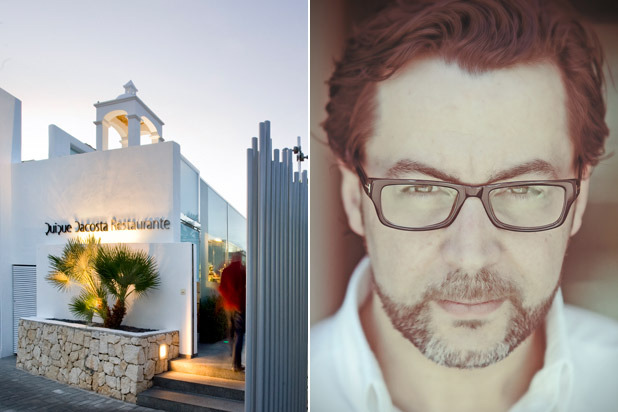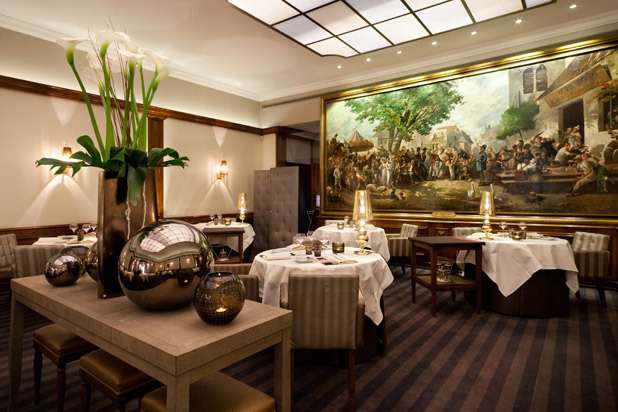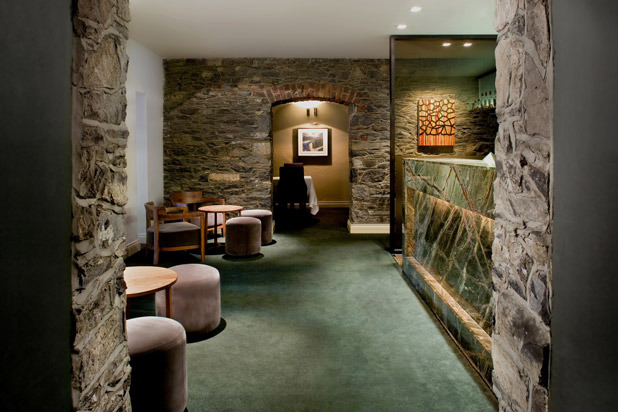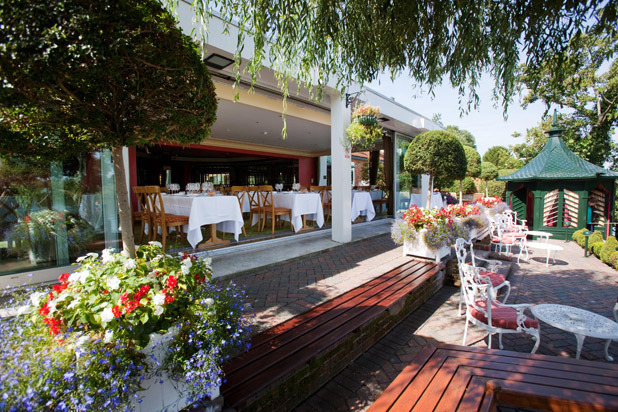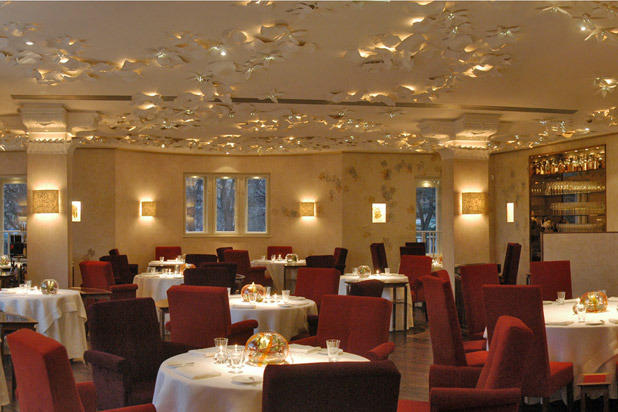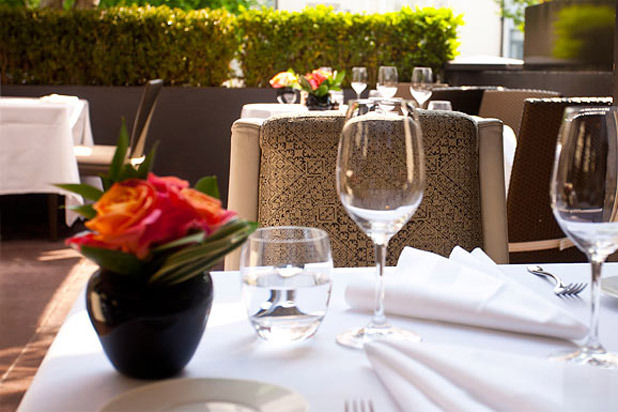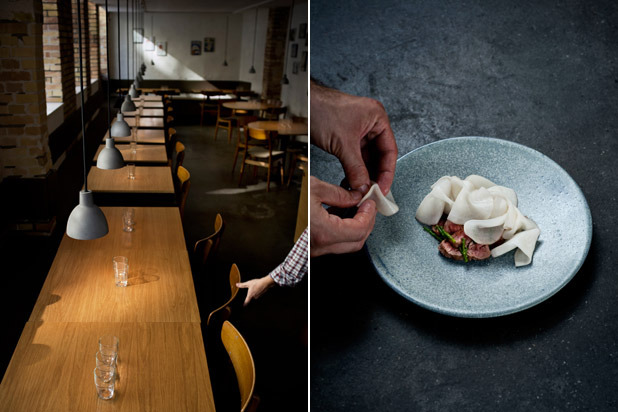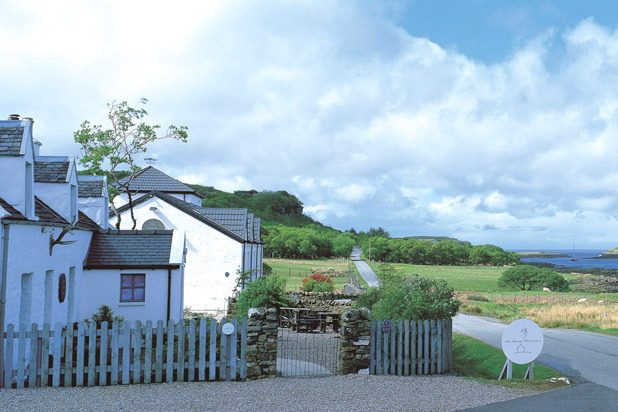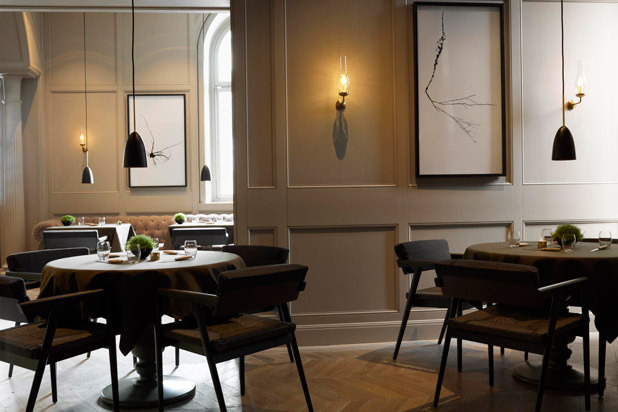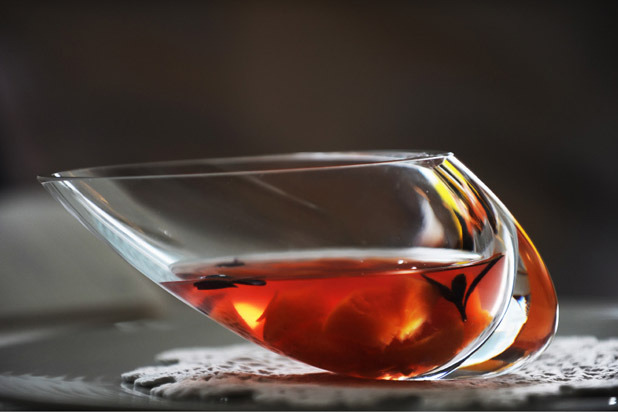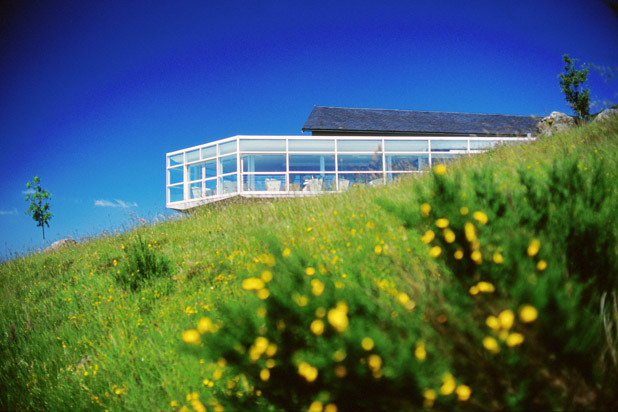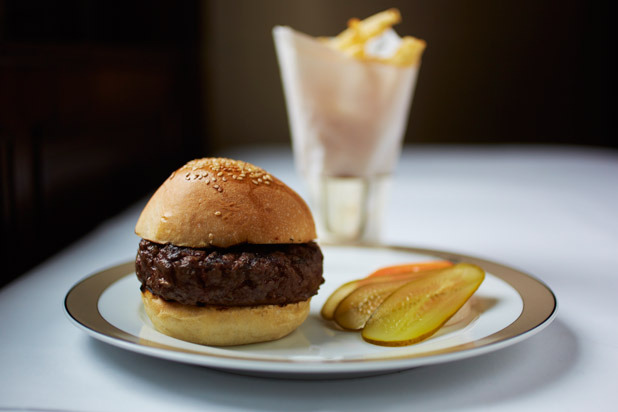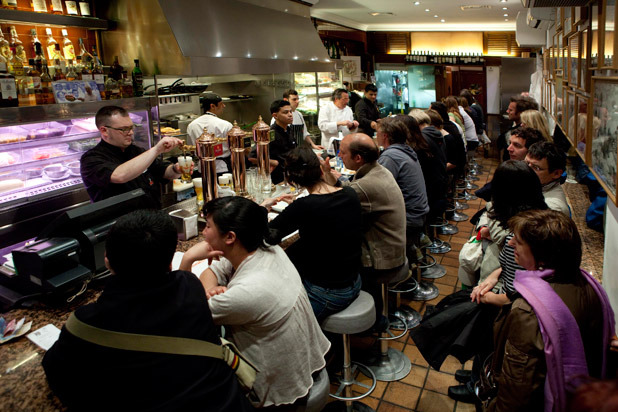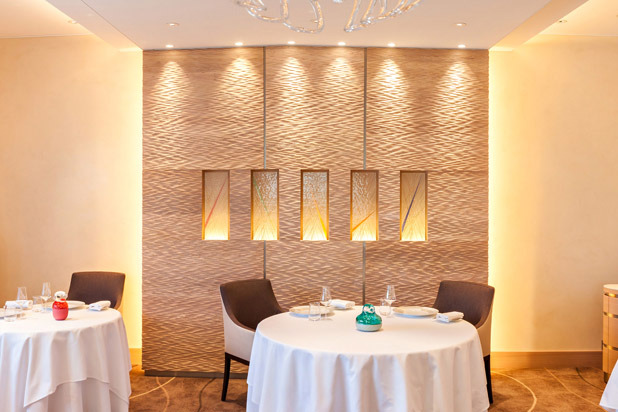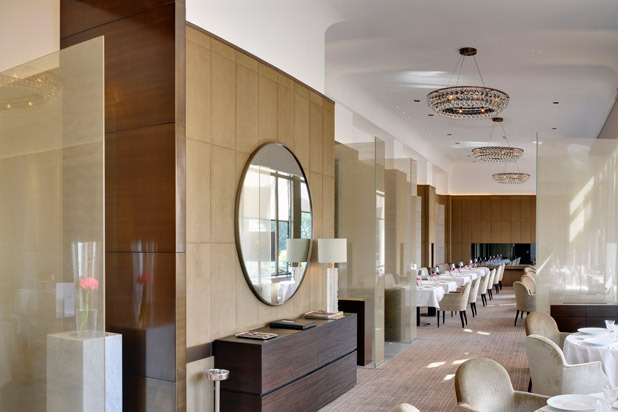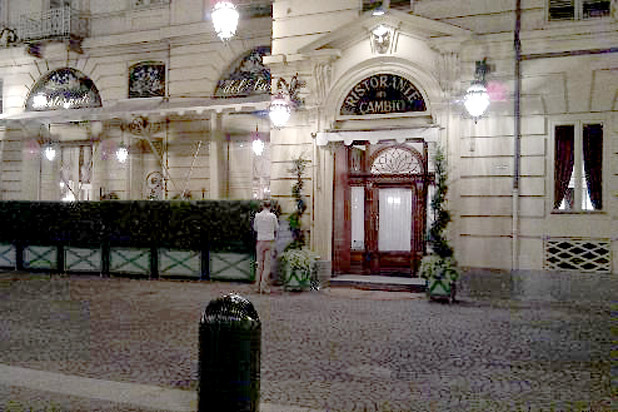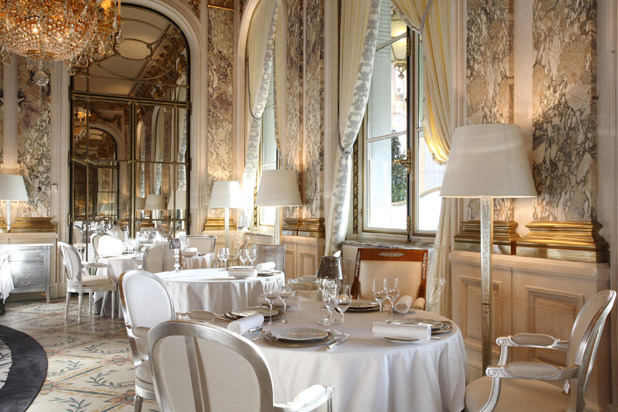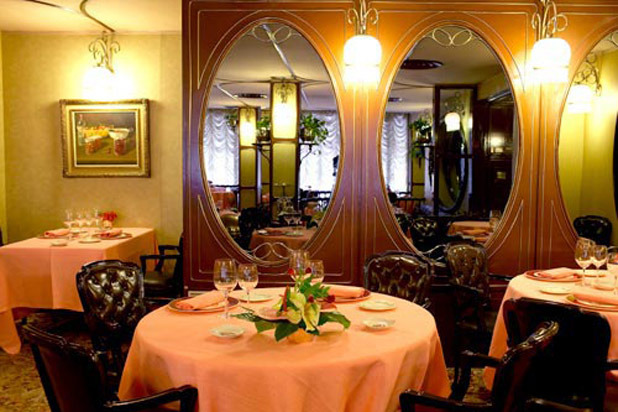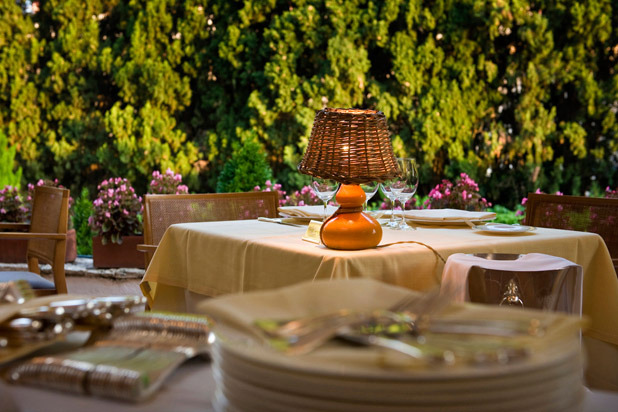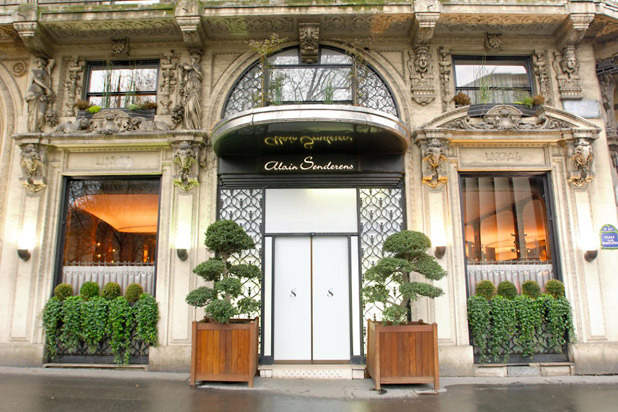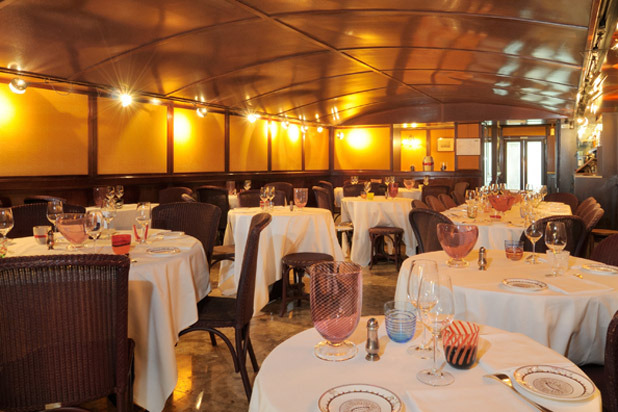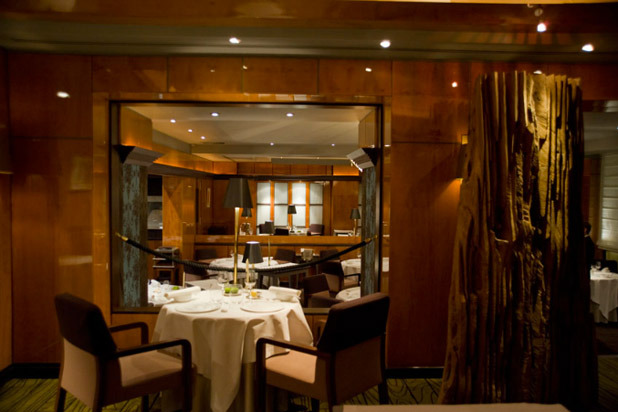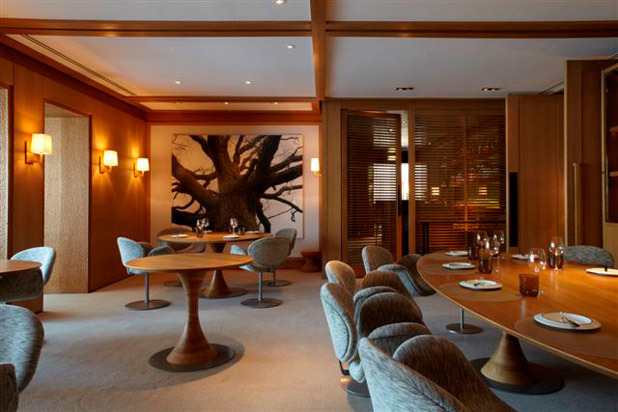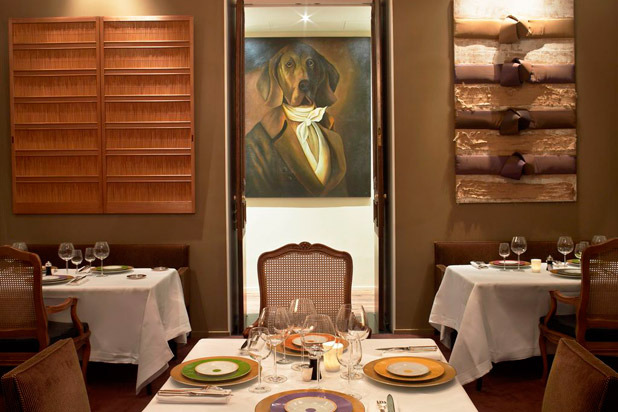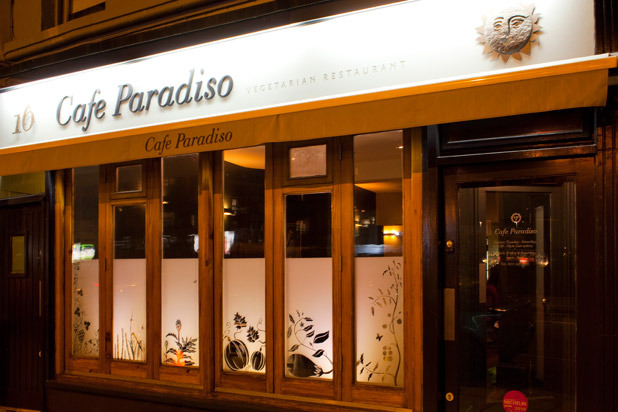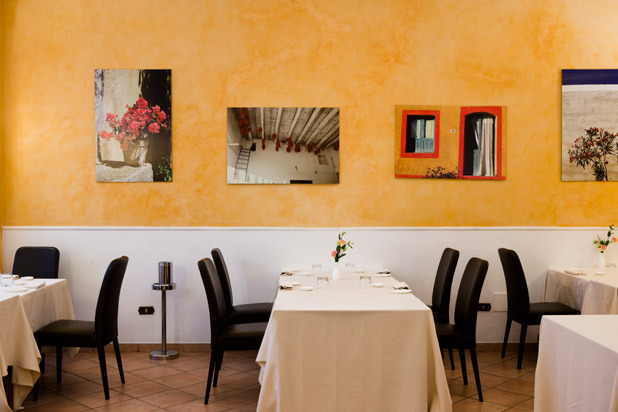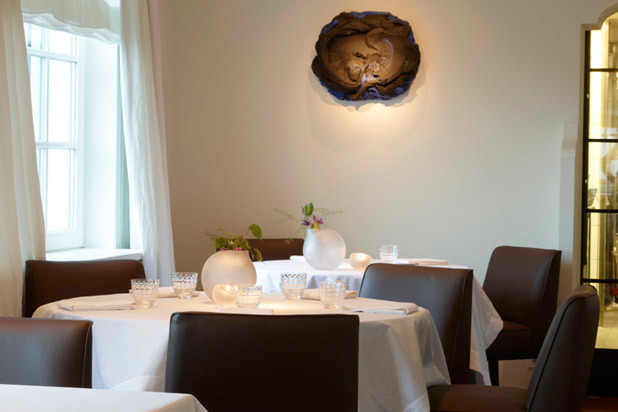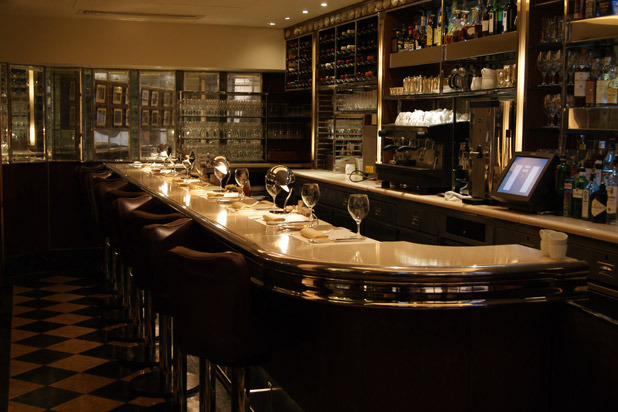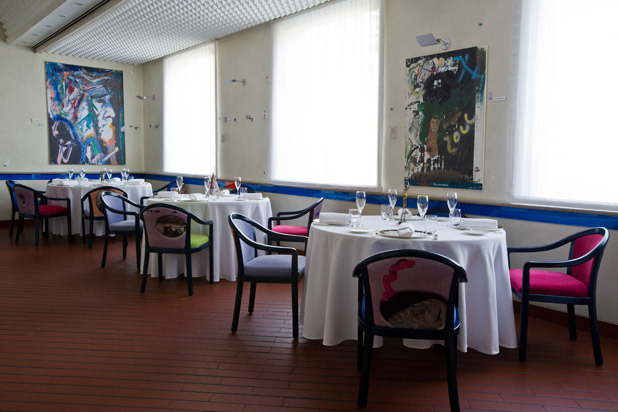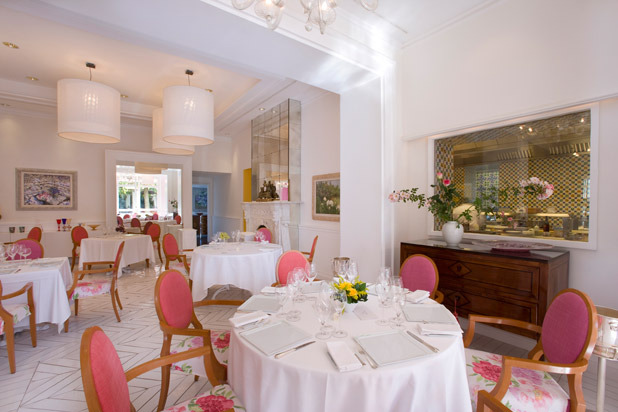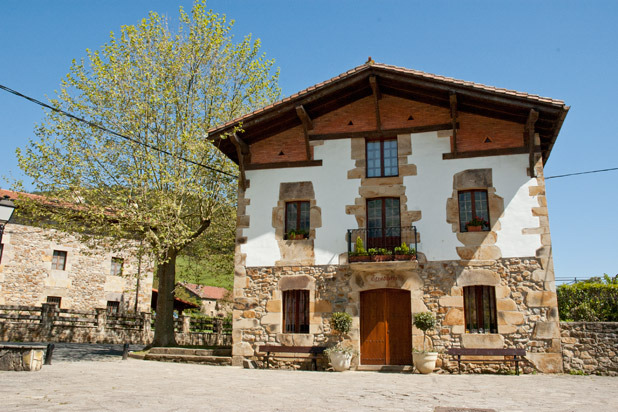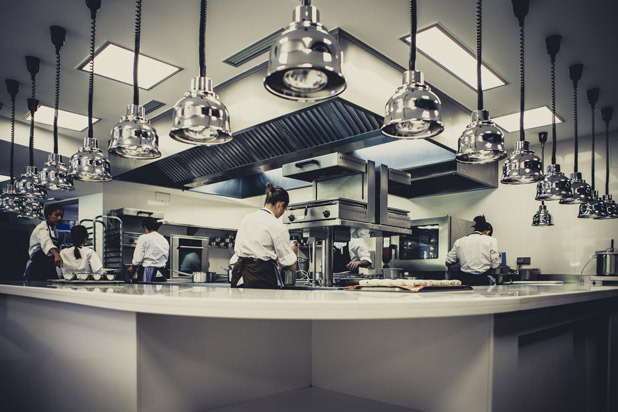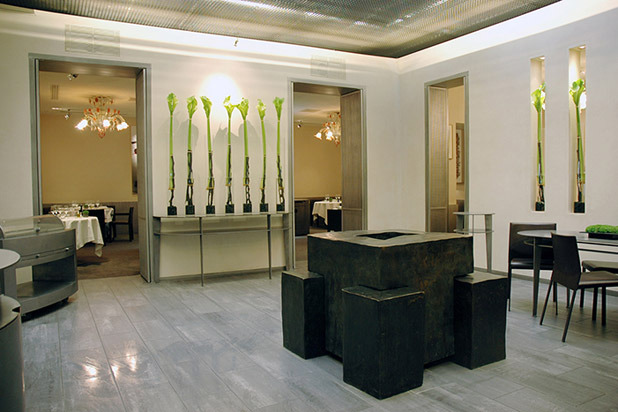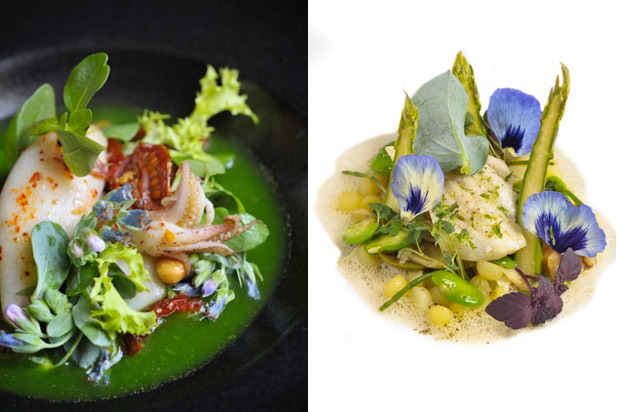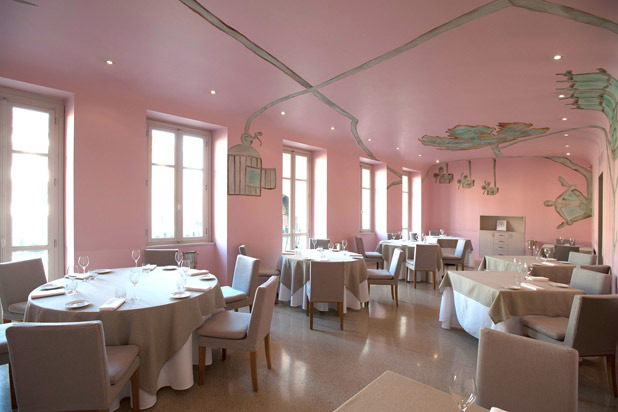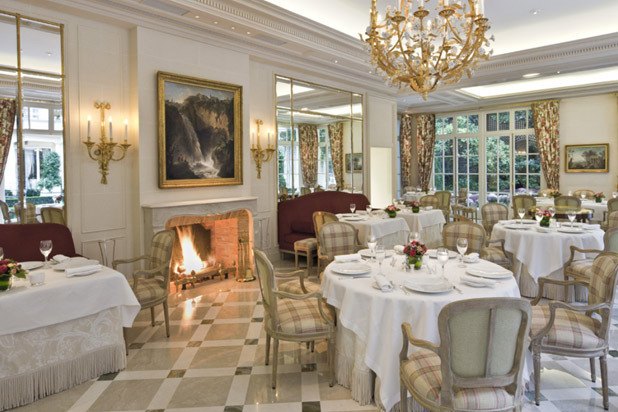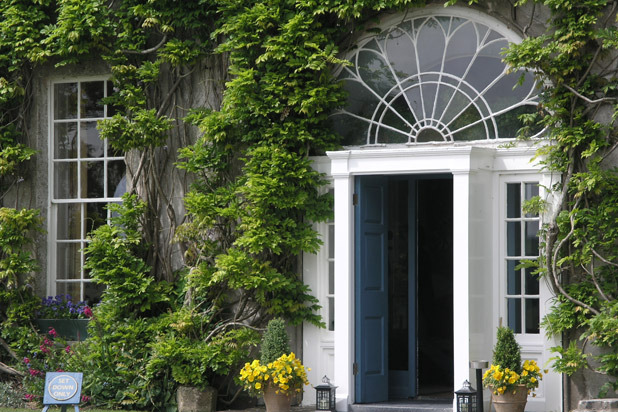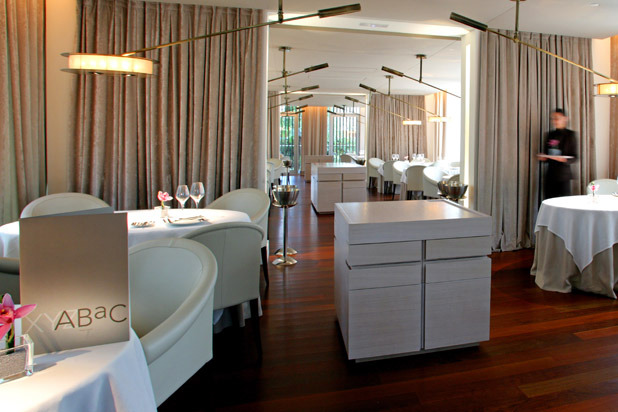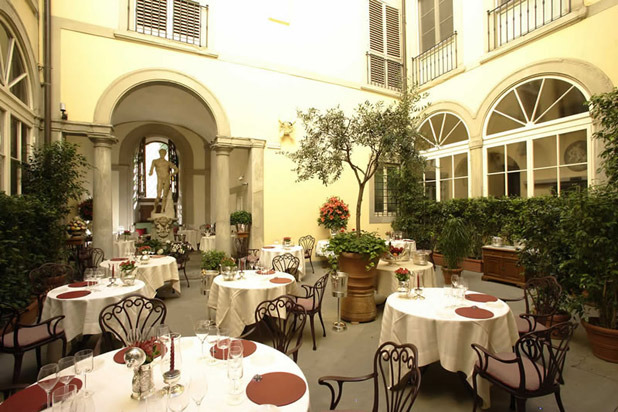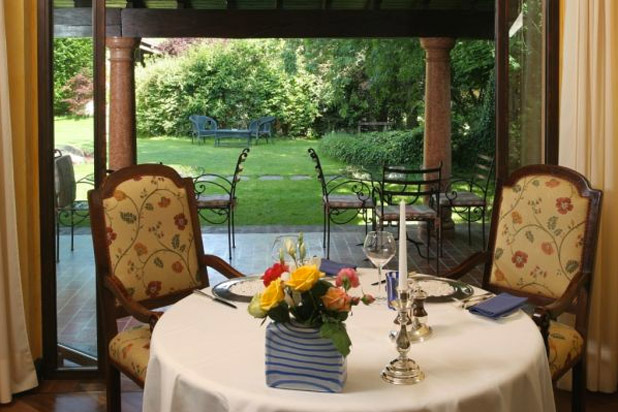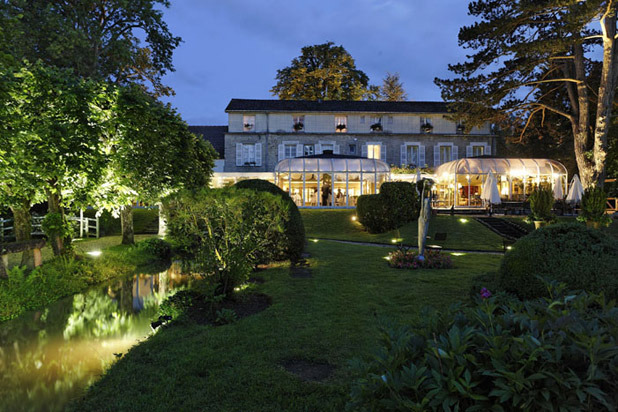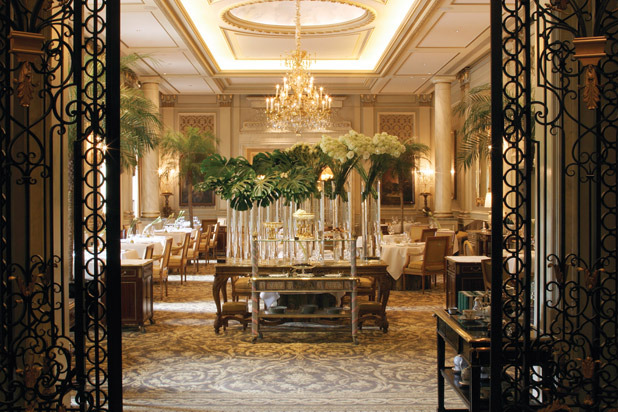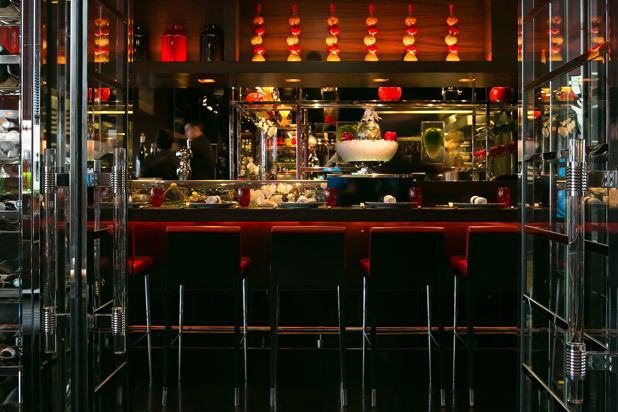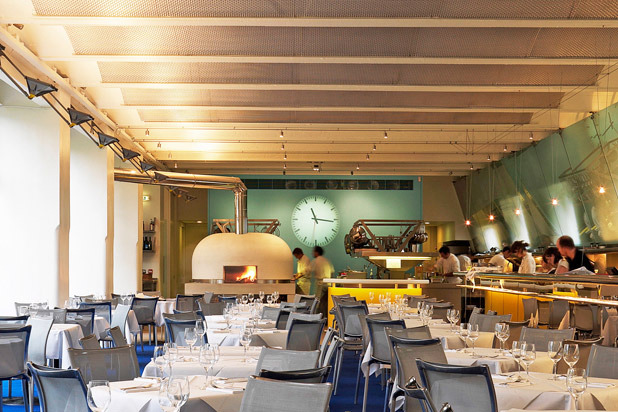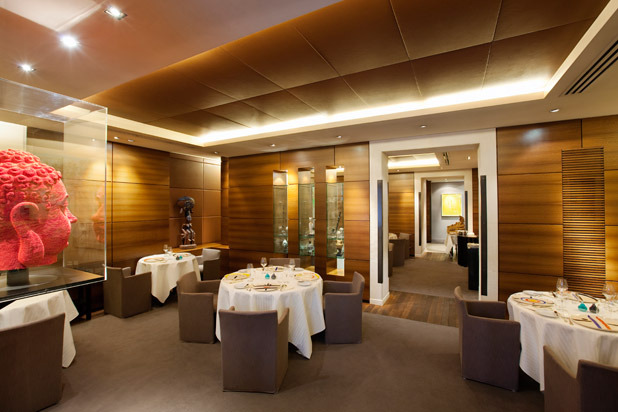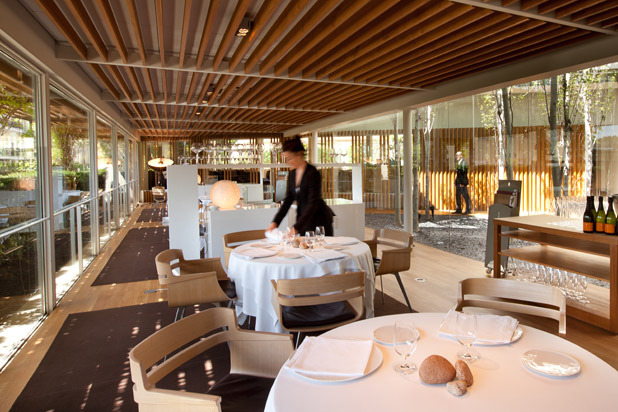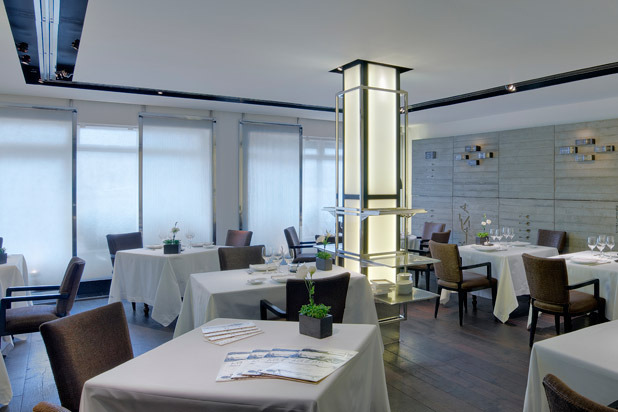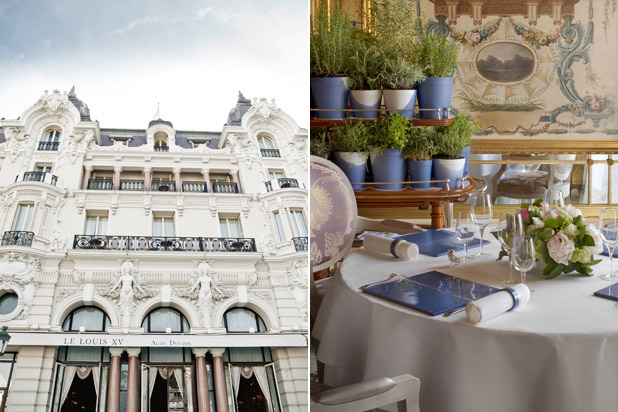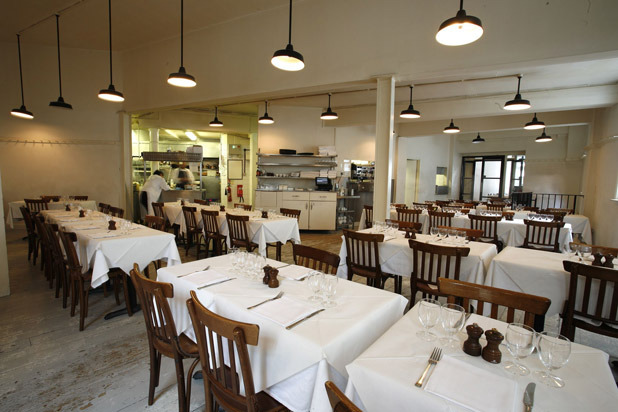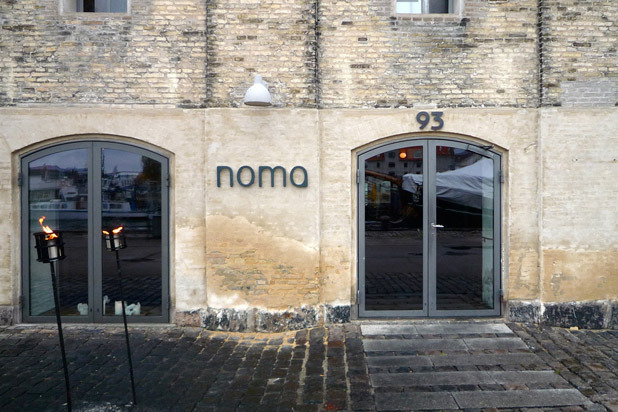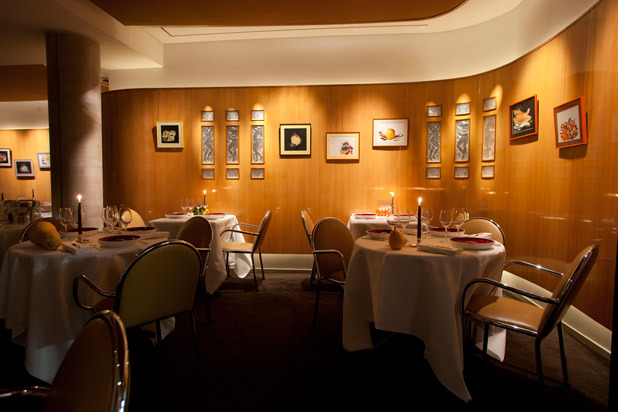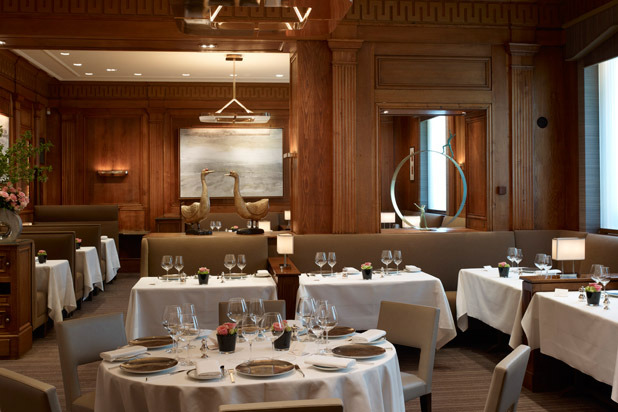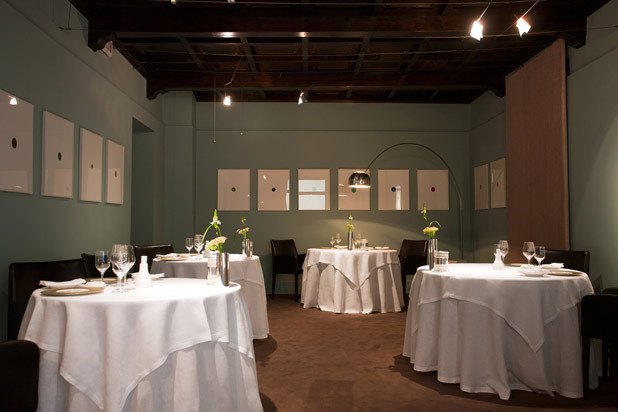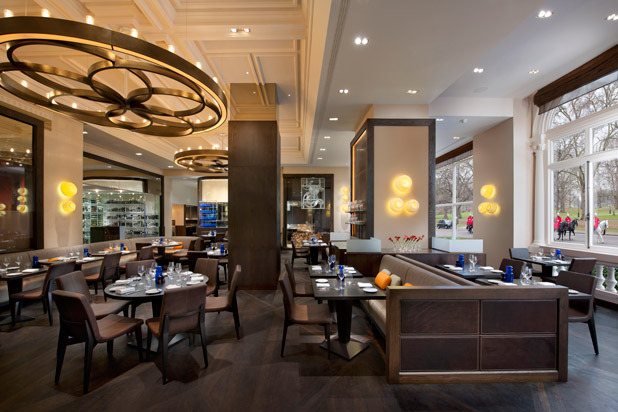101 Best Restaurants In Europe 2013 (Slideshow)
Given its setting on the harbor for which it's named for, it shouldn't surprise anybody that this Croatian restaurant specializes in both water vistas and seafood. The bread is homemade and served with local olive oil, appetizers include a variety of bruschetta and carpaccio, and enticing hot appetizers like snail risotto with sour apple and curry, grilled mussels, and black cuttlefish and chickpea stew. Entrées are just as difficult to decide between. Squid from the Adriatic, salt baked fish, grilled Adriatic lobster, and special sides like monkfish "tripe" and homemade ravioli with crab are among the offerings that have made this a must for local diners and visitors alike.
100. Hakkasan Mayfair (London)
Outposts of this high-end Chinese establishment (created by the founder of the low-end Wagamama Japanese noodle chain) — there are Hakkasans in New York City, Las Vegas, Miami, San Francisco, Los Angeles, Abu Dhabi, Dubai, Doha, Shanghai, and Mumbai, plus a second London location — have been criticized for their precipitous prices and the uneven quality of their cooking. The original, though — while indeed pricey — maintains high culinary standards in a sleek, buzzy, multi-million-dollar interior. The offerings run the gamut from jewel-like dim sum served as a sample platter (scallop shumai, har gau, Chinese prawn and chive dumpling, and duck dumpling) to bright seafood (roasted silver cod with champagne and honey), and from homemade tofu dishes (served in an aubergine and Japanese mushroom claypot with chile and black bean sauce) to extravagances like black truffle roast duck with tea plant mushroom.
99. Locks Brasserie (Dublin)
Overlooking the Irish capital's Grand Canal, in the vaguely bucolic Portobello district, this comfortable French-flavored place, using many prime ingredients and occasional culinary inspirations from Ireland, won a Michelin star last year for such dishes as pigs' feet and snail carpaccio with ham and raisin beignet; scallops with squid ink taramasalata, apple and parsnip aioli, and shaved cauliflower; poached stone bass with lardo, watercress, parsley farfalle, jamón ibérico, sea lettuce, and bacon sauce; and loin of rabbit with black bacon, corn, carrots, polenta, and mushrooms.
98. La Rosetta (Rome)
"Only fish since 1966." That's right, La Rosetta, founded by Carmelo Riccioli, claims to be the first restaurant in Rome to exclusively offer fresh fish and nothing but. Carmelo's son Massimo carries on the tradition today. There's an oyster bar with ample variety, including Venus clams as well as Belon, La Belle du Nordet, and Papin-Poget oysters, among others. And the menu features seafood every which way you can imagine (grilled, fried, steamed, seared, and raw). Scallops with orange sauce and vanilla salt, small spicy calamari with Amalfi lemon, tuna with strawberry vinegar and thyme, risotto with langoustines, pumpkin blossom cream and Pecorino foam — how do you choose?
97. Ca l'Isidre (Barcelona, Spain)
Isidre Gironès is a veteran Barcelona restaurateur, but still goes to the markets himself every morning and still shoots game birds in season that will end up on his table. His is an old-style restaurant, small, comfortable, and woody, with a mostly traditional menu offering some of the best jamón in town; ravioli with foie gras, truffle, and port wine sauce; soupy rice with seafood; roast baby goat with small onions; and the like. Some less common choices might be grilled sea cucumber; lamb brains in black butter; pig's foot stuffed with mushrooms, foie gras, and truffles,; and white peach with English cream. Come to Ca l'Isidre for the old-fashioned virtues of consistent cooking, excellent service, and an overall feeling of well-being.
96. Postres (Helsinki)
Located along Helsinki's main esplanade is Postres, a sleek restaurant in the modern Scandinavian design style with seasonally changing prix fixe menus. Founded in 2006 by Samuli Wirgentius and Vesa Parviainen (who left to pursue a career as pastry chef for Mast Brothers Chocolate in Brooklyn, N.Y.), Postres is one of several newer restaurants that showcase Helsinki's growing culinary sophistication, where locally sourced ingredients and refined Nordic cuisine are the new norms. At Postres, the cuisine is fittingly Scandinavian, but prepared with simplicity in mind, with traditional French techniques. Sample dishes include salmon with gooseberry and horseradish, pork with cauliflower and mangold, and apple with spruce and almond. Postres won a well-deserved Michelin star in 2008.
95. Moro (London)
Husband and wife Sam and Sam Clark bought a camper van and set off through Spain, Morocco, and the Sahara for three months, returning to London to open up Moro in the spring of 1997. The menu reflects the travels: Spanish and North African food, cooked and served simply, in the form of shared tapas or plates off the grills. Think chargrilled squid with harissa, wood-roasted meats, and grilled fish fillets, served alongside an extensive Spanish wine list and a selection of sherries.
94. Il Desco (Verona, Italy)
Chef Elia Rizzo's two Michelin-starred restaurant, which opened in 1997, uses modern techniques to highlight traditional Italian ingredients in a room filled with wood paneling and tapestries. The food, meticulously plated to artistic effect, includes vegetarian and seafood options (red prawns gratin and monkfish with sweet and sour sweetbreads beckon), but there are also such meatier delights as scampi and goose liver in onion sauce with wine caramel, duck breast with grappa sauce, Piedmontese beef fillet with Amarone sauce, and suckling pig with bean sauce and black truffle.
93. Stravaigin (Glasgow, Scotland)
"Stravaig" means to wander, a word that the folks behind this Glasgow hot spot chose to represent their "Think Global, Eat Local" ethos. At Stravaigin, a Michelin-starred restaurant with three levels with varying degrees of formality, all offering a hale and hearty welcome, that means a menu which features Scottish ingredients untethered to Scottish roots. It's typical to find dishes like haggis, Scotch beef burgers, Perthshire pigeon, and Carsphairn venison sharing space with kali dal, kimchee, sticky rice cakes, and salbitxada. And the jumble works.
92. Chez Bruce (London)
Opened in 1995, Bruce Poole and Nigel Platts-Martin's Chez Bruce serves modern cuisine from chef Matt Christmas that's based on French and Mediterranean ingredients. Known for a killer cheeseboard, homemade charcuterie, house-made bread, and offal, salads, and desserts, the menu itself might sound traditional, but the team draws from Italian, Spanish, and even Malaysian influences, bringing world cuisines to the food desert that is Wandsworth Common.
91. Harry's Bar (Venice, Italy)
Yes, it's something of a tourist trap; yes, it's usually crowded and noisy (with non-Venetians often in the majority); yes, the service can be desultory if you're not well-known; and yes, it's stunningly expensive (around $80, for instance, for the famous carpaccio — which was invented here, but still...). On the other hand, it is Harry's Bar, a landmark, a must. If you don't at least stop in, at least for an icy cold martini or maybe a Bellini (also invented here), it's almost as though you haven't really been to Venice. And the truth is that if you're in the 1 percent, or are pretending for the evening as if you are, and you don't make yourself crazy by translating that big euro number into your hard-earned dollars, the atmosphere here can be truly magical and the food can be really good. Such dishes as scampi with Lamon white beans, breast of veal (or turkey) with tuna sauce, baked green tagliolini with ham and cream sauce, calf's liver alla Veneziana, cuttlefish with polenta, and of course that carpaccio are genuinely delicious. And, hey, Orson Welles, Noel Coward, Charlie Chaplin, and of course Ernest Hemingway drank here.
90. Le Café Anglais (London)
Rowley Leigh, who cooked at the popular Kensington Place for 20 years, now runs this modish second-floor bistro–brasserie, serving first-rate French and British fare. The oyster bar dispenses Gillardeau Spéciales and Fines de Claires from France, pickled herring with sour cream on rye, and raw scallops with ginger dressing, among other things. From the kitchen come Parmesan custard with anchovy toast, griddled prawns with garlic and parsley butter, grilled rump steak with chips and béarnaise sauce, and (in season) roast grouse with game chips and bread sauce. Service is adept, wines are good and fairly priced, and the cooking is textbook perfect
89. The Goring (London)
The 1910-vintage Goring is an old-style hotel, with a discreet lobby, a bustling (but hardly buzzy) bar, and a dining room whose solid British cooking, both traditional and guardedly modern, is perfectly served by an attentive and knowledgeable staff. Native oysters, potted shrimp, fried whitebait, and a glazed Scottish lobster omelette are among the always-dependable starters. Main dishes might include roasted red mullet with foraged nettles and mussels; grilled Cornish brill with steamed razor clams, Lannigan shrimps, and baby spinach; and braised shoulder of Leyburn venison with bacon, button onions, and mushrooms. If you're in a particularly retro mood and get there on the right day, the silver-domed trolley that glides around the dining room might be featuring a classic beef Wellington.
88. The Witchery (Edinburgh, Scotland)
Set in a 16th-century merchant's house, The Witchery serves Scottish seafood, a signature steak tartare, and that most definitive of Scottish dishes, haggis. Lunch, dinner, and pre- and post-theater suppers are available. The sumptuously appointed baroque-style dining room includes ancient oak paneling and heraldic painted ceilings, tapestries, and antique candlesticks. Guests who stay at The Witchery, which is also a small hotel, are treated to candlelit breakfasts.
87. 21212 (Edinburgh, Scotland)
Paul Kitching turned a refurbished Georgian townhouse into a four-story Michelin-starred restaurant (with four rooms to stay in). The open kitchen serves 38 guests a menu limited to three options per course, although the menu changes weekly. Think French-based contemporary dishes like smoked chicken with rosemary cream, or corned beef and basil roots, not to mention a strawberry meringue float.
86. Onyx (Budapest)
Since its opening in Vörösmarty Square in 2007, executive chef Szabina Szulló and sous-chef Tamás Széll have led this 55-seat fine dining restaurant in Budapest to a Michelin star. The culmination of the restaurant's efforts? The creation of their Hungarian Evolution Menu, "where the freshest, highest-quality domestic ingredients and new technologies are used in the preparation and presentation of renewed and updated versions of traditional Hungarian cuisine." Consider dishes like water buffalo steak tartare with oxtail and oyster; goose liver with grapes; free-range egg with Mangalitsa ham, potato, and truffle; goulash soup; venison with black pudding toast, walnut, apple, and cabbage; and a "21st century Somló sponge cake" — all served in a black-tiled dining room with silver ceilings, chandeliers, orchids, and of course plenty of onyx.
85. Zum Schwarzen Kameel (Vienna)
Beyond music, food may just be one of the best ways to time-travel, to experience the vanishing memories of flavors from eras long passed. And Zum Schwarzen Kameel, one of Europe's oldest sandwich shops, in the heart of Vienna's first district, has been run by the same family for at least 200 years. Open-faced sandwiches are the specialties here, hand-carved Beinschinken (boiled ham with horseradish) served on black bread by uniformed waiters at the café outside or in the Art Deco dining room, and savored with a glass of Austrian wine while people-watching and eavesdropping. It isn't complicated, but it's pretty perfect.
84. Clarke's (London)
When Sally Clarke opened her eponymous restaurant in Kensington almost 30 years ago, light, bright, seasonally and regionally based fare of the kind that was then associated, rightly or wrongly, with "California cuisine" was all but unknown in London. Clarke, who had in fact worked in restaurants in California and befriended Alice Waters (following her studies at the Cordon Bleu in Paris), introduced the idiom there. Since that time, she has expanded to open a splendid food shop next door and establish a wholesale bakery that supplies bread to many good London restaurants, but she has also continued to produce her style of savory, brightly flavored, scrupulously fresh food to a populace that has long since learned to appreciate its merits. Clarke's menus change daily. There's a Chez Panisse-style fixed-price offering (sample: bufala mozzarella with Italian pears, purple figs, hazelnuts, land cress, escarole, and pomegranate dressing; grilled paillard of Lancashire chicken with girolles, rosemary, walnuts, and cream; and warm apple and quince crumble with quince ripple ice cream) but also a small à la carte listing. Typical Clarke dishes: spinach, leek, and potato soup with herbed breadsticks; ricotta and spinach ravioli with pea leaves, toasted chestnuts, and aged Parmigiano; and char-grilled veal chop with parsnip crisps, watercress, and lemon and sage butter.
83. Anna Sacher (Vienna)
One might think that the original Anton Faistauer paintings that adorn the bright green walls and the eye-catching Lobmeyr crystal chandeliers in the renovated dining room of Anna Sacher inside the Hotel Sacher would compete for attention with chef Werner Pichlmaier's menu, but his simply conceived but ornately presented dishes stand on their own. Pichlmaier uses regional ingredients in his interpretation of Austrian cuisine, adding personal twists that make the à la carte dishes and set menus both unique and irresistible. The spiny lobster with tamarind and lime, goose liver with musky pumpkin and hazelnut, and Guanaja chocolate with blackberry and macadamia nuts are prime examples of Pichlmaier's culinary aesthetic.
82. Selene (Santorini, Greece)
The aim of Selene, to promote local products and cuisine, has remained the same since it opened 27 years ago in Fira, on the island of Santorini. In the decades since, Selene has moved to the center of Pyrgos and is perched on one of the highest points on the island, affording amazing views from the dining room. Located adjacent to some of the island's famous vineyards and farmland, Selene has a new chef, Nikos Boukis, but the locally inspired food remains extraordinary. The menu includes offerings like sardines in bread tart, served with beet carpaccio, walnuts, and walnut oil; and rabbit marinated in red wine, served in herb-scented pastry with variations of onions. Since moving to Pyrgos, the restaurant has added a more informal tavern and a folklore museum featuring exhibits on traditional agricultural production. Visitors can indulge in a package that includes wine tasting, a museum tour, cooking class, and dinner.
81. Restaurant Français (Frankfurt, Germany)
Chef Patrick Bittner has proven himself a master of gourmet French cooking technique, but the menu at Restaurant Français is a mix of European influence. Alsatian goose liver is plated with apricot and artichoke, while scallops with pine nuts, chicory, and Burgundy truffles fuse together flavors from sea and land. The elegant dining room offers a picturesque view of Frankfurt.
80. La Taberna del Gourmet (Alicante, Spain)
A tapas bar raised to the highest level, this Alicante hot spot, with its long white marble counter and its cozy back dining room, serves all manner of only-in-Spain wonderments: big green Tarragona olives, pitted and faintly spicy; fabulous jamón ibérico (and also espaladita, pork shoulder cured like ham); the tiny, buttery boiled pink shrimp called quisquillas; lightly charred dried octopus tentacles, sliced into discs the size of quarters and drizzled with good olive oil; whole cuttlefish, about 3 inches long, scored and quickly seared; subtly seasoned blood sausage, locally made; grilled medallions of a fish locally known as negre, "black," whose firm, intensely flavorful meat is in fact snowy white. Everything glows with freshness, and the impeccable quality of the raw materials is honored by the sure-handed simplicity of the preparation. This is not a fancy place, but it is restaurant perfection.
79. Trussardi Alla Scala (Milan)
At Trussardi Alla Scala "each recipe is like a documentary film in which every ingredient plays a key role. And in this special story, there are only protagonists, not bit players." At least, that's how the restaurant describes itself. Sounds quintessentially Italian, right? And yet chef Luigi Taglienti's Michelin star wasn't purely derived from Italian recipes. Expect the unexpected, like cubes of veal "Milanese style" with lemon potimarron and cinnamon green apple; veal snout braised with spumante, mackerel, cucumber, and black truffle; and tiramisu with black truffle, from Milan's sleek, modern Ristorante Trussardi, which tips its cap to classic French recipes and avant-garde techniques.
78. Paolo e Barbara (Sanremo, Italy)
Since 1988, Paolo and Barbara Masieri have served residents of and visitors to the pretty town of Sanremo, on the Italian Riviera, their version of classic Ligurian cuisine, updated and refined. Think dishes like local Sanremo shrimps on Jerusalem artichoke cream with bitter orange marmalade and baby salad and flowers; or baby squid stuffed with wild green herbs on Castelvittorio beans, cream, and pimpinella oil; and a dessert such as pear mousse with wild blackberry sauce and pistachio cream. Most of the vegetables used by the kitchen at Paolo e Barbara come from the Masieris' own farm, and the breads and focaccia (a specialty of the region) are made in-house with organic hand-milled flour.
77. Patrick Guilbaud (Dublin)
Before young Irish chefs started creating good modern food of their own, the best restaurants in Dublin were French — most notably Jammet's and the dining room of the Russell Hotel (which guidebook author Egon Ronay called "one of the best restaurants in Europe"). There are those who would say that the island's finest eating place is still French — Patrick Guilbaud's, affectionately known to locals as Paddy Giblet's. Guilbaud and his longtime executive chef, Guillaume Lebrun, have a beautiful restaurant, downstairs at Dublin's top-of-the-line Merrion Hotel (like the hotel itself, the restaurant is full of good Irish art). Here they serve complex, refined French dishes based on Irish raw materials. Sample fare: suckling pig croquettes with fried quail eggs and foie gras; blue lobster ravioli made with free-range egg pasta, coated in coconut-scented lobster cream, toasted almonds, and split curry dressing; terrine of smoked eel and potato; and green apple parfait with pistachio ice cream, meringue, and vanilla espuma.
76. La Ciau del Tornavento (Treiso, Italy)
In the middle of Piedmont's red wine and white truffle country, La Ciau del Tornavento in an unpretentious looking country inn serves food that is intelligently conceived and beautifully cooked, marrying traditional ingredients and flavors with contemporary techniques. Sample dishes include shrimp with Stracciatella burrata and tomato confit; pheasant agnolotti with chestnuts; and Giauduja tartlet with ice cream flavored with sweet pipe tobacco. If you are fortunate enough to visit in white truffle season — approximately October through early December — splurge on the hand-chopped steak tartare, the poached eggs, or the tagliolini, all generously covered with grated tartufi bianchi.
75. Quo Vadis (London)
Jeremy Lee has long been one of the best no-nonsense, seasonally aware cooks in London, but in his berth at the Blueprint Café atop the city's Design Museum, he never got the attention he deserved. Now he's in the middle of Soho, at the old-line (but newly revivified) Quo Vadis. His wonderfully British menu ranges from (at this time of year) smoked trout, cucumber, and seaweed sandwiches and crab with mayonnaise to ox tongue with carrots, and beetroot relish. The room is pretty, the cooking is just right, and the wines are well-chosen.
74. Da Vittorio (Brusaporto, Italy)
The menu at Da Vittorio changes with the market and the season. Despite its inland location in Lombardy, near Italy's lake district, the restaurant is known for its outstanding seafood dishes, and diners even have the option of a tasting menu focused solely on fish and crustaceans. Carnivores will be satisfied with dishes like candied baby pork belly, Wagyu beef with cauliflower, or pigeon with cabbage and wild blueberry sauce.
73. The Yeatman (Vila Nova de Gaia, Portugal)
The luxurious Yeatman hotel in Vila Nova de Gaia, across the Douro River from Porto, boasts the region's only Michelin one-star with its formal dining room. The cuisine of chef Ricardo Costa is French in technique, international in inspiration, and mostly Portuguese in ingredients. Roasted miniature squid and crayfish in a trumpetfish cream; roasted octopus tentacle with creamy rice and light octopus sauce; a combination of confit pork cheek with pearl barley risotto and pork tenderloin with cured ham, the meat from Portugal's celebrated Bisaro pigs; persimmon sorbet and granité with champagne biscuits, persimmon mousse, and nougat... This is a long way from the rustic fare for which Portugal used to be known. An added virtue of the place is the extensive wine list, full of great vintages from France and elsewhere but also packed with a wide range of excellent if little-known Portuguese wines, through whose complexities a knowledgeable sommelier will guide you.
72. Rafa's (Roses, Spain)
Ferran Adrià's go-to restaurant in Roses, the nearest big town to his elBulli, is this tiny, bare-bones establishment on a Roses side street, where Rafa Nadal, who knows the fish and shellfish of this piece of coast better than anyone, cooks the simplest, most perfect food imaginable. There is no menu, just a display case with fresh local sea creatures of the highest quality. A waitress tells diners what's available. Diners choose. Nadal puts a little more olive oil on his griddle, adds the seafood, and a few minutes later, the most exquisite things appear on the table — shrimp, langoustines, sea cucumbers (the kind the Catalans call espardenyes), squid, sardines, red mullet, gilt-head bream, monkfish... Whatever it is will be at its peak. Nadal has been known to close the place down when he runs out of raw materials he considers good enough to serve. The service here is efficient, the wine list is small but decent, and the experience is not to be forgotten.
71. Akelaŕe (San Sebastian, Spain)
Akelaŕe is a Basque word meaning "coven of witches," and chef Pedro Subijana's breed of culinary witchcraft merges traditional Basque flavors with gastronomic innovation. With a panoramic view of the Atlantic Ocean, the restaurant's menu highlights outstanding seafood dishes, like flambéed prawns with French beans or scampi with smoked monkfish. The chef's imagination runs wild with desserts such as "gin-tonic on a plate" and "warm red fruit cake, with caramel-coated fennel."
70. Restaurant Joël Robuchon at Hôtel Métropole (Monte Carlo)
Celebrated chef Joël Robuchon's Monte Carlo restaurant pays tribute to Mediterranean cuisine. Dishes avoid the frill of modernist trends and keep the focus on local ingredients. Seafood is plated with Provençal vegetables or figs; lobster might be accompanied by pearl rice enriched with sea urchin; peppered lamb filet and spit-roasted capon are perfect in their simplicity. A selection of small plates gives diners the option to sample a range of the superior products from the kitchen.
69. Alain Ducasse at The Dorchester (London)
One of a trio of Alain Ducasse's restaurants to be awarded three Michelin stars, Alain Ducasse at The Dorchester serves contemporary French cuisine in a bright and airy space with blonde wood walls and crisp white linen-topped tables. Executive chef Jocelyn Herland uses seasonal produce from England and France to create the à la carte menu and three-course set menus. The menu includes dishes such as foie gras and Burgaud duck terrine with pickled muscat Hamburg grapes; hand-dived sea scallops, parsnips, Jerusalem artichokes, and salsify; rib and saddle of Denbighshire venison, pumpkin, and cranberries; and lime soufflé with confit kumquats.
68. L'Oustaù de Baumanière (Les-Baux-de-Provence, France)
In the charming Provencal village of Les Baux-de-Provence, L'Oustaù de Baumanière sets its tables in a garden of olive and mulberry trees. In this breathtaking setting, the restaurant, adjacent to a hotel and spa, serves a menu that marries French tradition with modern vision. Sylvestre Wahid who assumed duties here in 2005, offers frogs' legs in two forms, thighs in parsley sauce, lower legs in Parmesan cappuccino; blue lobster with Camargue rice soufflé; duckling cooked in fig leaves with foie gras and a gingerbread crust; and other imaginative creations, while his brother, pastry chef Jonathan, serves wild strawberries with hazelnuts, vanilla, and meringue, and fashions made-to-order ice creams and sorbets from grand cru dark chocolate, calamansi limes, and such.
67. L'Astrance (Paris)
Chefs Pascal Barbot and Christophe Rohat, former disciples of culinary legend Alain Passard, have earned three Michelin stars with their innovative modern French cuisine at this delightful restaurant. Barbot's signature dish is a galette of mushrooms and foie gras served with hazelnut oil and lemon curd. Other imaginative, colorful dishes on the always-changing menu fuse haute cuisine with global flavors.
66. Château de Chèvre d'Or (Èze, France)
It's more than the stunning views of the Mediterranean that have kept patrons coming to Château de Chèvre d'Or, a hotel restaurant nestled in a medieval hilltop village above the Côte d'Azur, for more than 60 years. The food has always been a major draw as well. These days, chef Ronan Kervarrec cooks local, seasonal ingredients with a modern touch: zucchini is dressed with orange peel and curried squash seeds, served alongside a tempura-fried squash blossom stuffed with smoked mozzarella. Fish pulled from the Mediterranean below is plated simply with olive purée and stewed vegetables, and there's no shortage of stellar meat dishes and inspired pastries.
65. Quique Dacosta (Dénia, Spain)
Probably the least known of the top Spanish avant-garde chefs, and one of the most daring, Dacosta combines traditional Spanish ingredients (red shrimp, eel, piquillo peppers, jamón, etc.) with such unexpected materials as oak bark, eucalyptus essence, and rompepiedra, a medicinal herb called stonebreaker in English, to create what he calls his "eco-cuisine" — a kind of edible landscape of the Costa Blanca, the southern Mediterranean littoral where his establishment is located. Visitors to his elegant Michelin-three-starred restaurant, situated in a traditional Valencian-style house, updated with frosted glass and contemporary art, will enjoy such unexpected offerings as a "snack" plate featuring several components like cep roots, dried corn leaf, endive leaf in a mandarin orange skin, "stones" of Parmesan, and dry-cured tomato. Various imaginative preparations of dried octopus, green almonds, pork marrow, sea eel, pigeon liver, and other elemental ingredients make up the balance of the menu The restaurant is currently closed for the winter season and will reopen again on Jan. 29, 2014.
64. Au Crocodile (Strasbourg, France)
Named for a stuffed crocodile brought back by a local general from the Napoleonic Wars in Egypt — a souvenir still displayed prominently in the restaurant's main dining room — Au Crocodile is a historic Strasbourg institution. The current chef, Philippe Bohrer, creates visionary dishes that pay homage to traditional Alsatian cuisine, like frogs' legs with nettle juice or roast blue lobster with lobster-stuffed cannelloni and a delicate shellfish foam.
63. Chapter One (Dublin)
In a warm basement dining room below the Dublin Writers Museum, its walls hung with superb contemporary Irish art, Cork-born Ross Lewis produces superb contemporary Irish food, based on first-rate ingredients prepared with imagination and a practiced hand. Lewis doesn't hesitate to work an occasional foam or emulsion into his food, but keeps his feet firmly planted in Irish soil. Typical dishes at Chapter One are game terrine with quince and mustard purée, pickled cherries, and land cress; scallops with a white bean and cockle stew, served with pumpkin purée flavored with smoked bacon cream, basil oil, and pickled pumpkin; smoked and cured loin of free-range pork with a pata negra crust, roasted king oyster mushrooms, seaweed and buttermilk potato, and pickled mustard seeds; and Irish blackberries with baked custard and gingerbread crumb, yuzu curd, and blackberry bombe.
62. The Waterside Inn (Bray, England)
Founded by brothers Michel and Albert Roux, of Le Gavroche, also on our list, The Waterside Inn was transformed from an English pub to a bucolic gastronomic destination on the banks of the Thames in Bray. Alain Roux's seasonal à la carte and three-course set menus — full of such delights as spinach and sorrel soup garnished with a small soft poached egg and chicken julienne; roasted cod tournedos with fresh herbs, stuffed vegetables, and olive oil sauce; roasted Gressingham duck breast with cherries and Bourgueil wine; and shortbread biscuit with an apricot mousse, currants, and rosemary-scented apricot sorbet — have earned him three Michelin stars.
61. The Square (London)
While the cuisine at The Square is by now familiar in style — modern French-inspired cuisine based on impeccable ingredients — few restaurants have executed this idiom so consistently for as long. Chef Philip Howard, a partner in The Ledbury (number 59) runs the kitchen of this stylish, grown-up dining room. With seasonally changing dishes like langoustine with Parmesan gnocchi or rib-eye with beer-braised onions and smoked bone marrow, it's clear why The Square has become one of the enduring bright spots on the London food scene.
60. Steirereck (Vienna)
Nature is the inspiration for two-Michelin-starred chef Heinz Reitbauer's cuisine, and for the décor at Steirereck. Dishes like wild boar's head with purple carrots, pineapple, radicchio, and buckwheat; broccoli with celeriac, sesame, Meyer lemon, and foie gras schmaltz; and barbecued sturgeon with kohlrabi, quinoa, and elderberry evoke the outdoors in form and freshness of flavor, while the dining room suggests a winter scene, with a neutral palette extending to the light cream walls and fixtures, offset by cushioned red chairs.
59. The Ledbury (London)
Chef Brett Graham worked his way through kitchens in Australia and the U.K. before opening this Notting Hill restaurant in 2005 in partnership with chef Philip Howard and restaurateur Nigel Platts-Martin, who's also behind The Square (number 61) and Chez Bruce (number 92). The atmosphere has been lauded for its unpretentious, down-to-earth vibe, a rare quality alongside Michelin-starred food. The menu changes with the seasons, with some standouts including the flame-grilled mackerel with pickled cucumber, Celtic mustard, and shiso; neck of lamb with aubergine, pardon peppers, and garlic; and desserts like the sliced figs with honey, vanilla, olives, and toasted sourdough ice cream.
58. Relæ (Copenhagen, Denmark)
The unpretentious atmosphere at Relæ may seem at odds with the high-end gastronomic experience you'll enjoy here. With plain white walls and stark wooden tables, minus tablecloths, the dining room is simple and purposely understated; chef Christian Puglisi believes that the real focus of the evening should be the food — and food of good quality. At Relæ practically everything put on plates or poured in glasses is organic, and the restaurant is the only Michelin-starred restaurant in the world with an organic certification. Puglisi's cuisine is best experienced by booking Table 0, a four-seat oak table near the kitchen, where the chef and his team serve an experimental menu of 10 to 12 courses, giving a handful of diners each week the chance to see Puglisi's creative impulses, sampling dishes that may one day make it onto the main menu. Sample dishes include squid with leeks and bergamot; lamb from Havervadgård with bitter leaves and black tea; and smoked almonds with oats and apple granité. An all-vegetable menu is also offered.
57. The Three Chimneys (Isle of Skye, Scotland)
For three decades, Eddie and Shirley Spear have been serving Scottish food and hospitality at The Three Chimneys on the shore of Loch Dunvegan in the remote northwest corner of Skye, an island off the west coast of Scotland. Spread across three small dining areas on the ground floor of a 120-year-old crofter's cottage, the restaurant serves lunch from mid-March until the end of October; dinner is served nightly all year long. The set-menu-only restaurant offers a three-course dinner menu and a seven-course Skye Showcase menu, which can be served at one of the wooden tables topped with crisp white linens or at the kitchen table. Courses include red mullet with fennel, Moonen Bay lobster, and Tomalley butter; saddle and haunch of Lochalsh venison with crowdie clapshot (mashed potatoes with Scottish cream cheese), bacon, and plum; Loch Dunvegan langoustines with Tattie scones (potato scones) and Bridget's organic mesclun; and Three Chimneys' hot marmalade pudding soufflé with Drambuie syrup and sweet corn ice cream.
56. Mathias Dahlgren Matsalen at Grand Hôtel (Stockholm)
Swedish chef Mathias Dahlgren's Michelin two-starred Matsalen serves internationally inspired Swedish cuisine in a bright, modern, minimalist setting appointed with burnished wood, velvet, and brass. The seasonal menu changes daily and includes two tasting menus: "The Natural Cuisine," which changes with the seasons, and "A Theme in Focus," which highlights something the kitchen finds interesting at the moment. The menus can be paired with wine, sake, beer, or other drinks. Typical Dahlgren specialties include salmon with whitefish roe, artichoke purée, and asparagus tips; an amuse bouche of Swedish squid, lobster, cucumber, salmon roe, tapioca, beurre noisette, yogurt, and coriander; and smoked pork belly with cabbage, consommé, and daikon. Matbaren, an adjacent bistro bar that serves medium-size dishes and wine by the glass, is worth trying if you can't book a table at Matsalen.
55. Le Comptoir at Hôtel Relais Saint Germain (Paris)
Located in the picturesque Relais Saint-Germain Hotel in the heart of Paris, Le Comptoir is a tiny bistro featuring the cuisine of "bistronomy" pioneer Yves Camdeborde. His bargain-priced, no-choice, multi-course evening menu has made a dinner reservation here one of the hardest to get in town. (Recent dishes included octopus soup with truffle oil lentils; stuffed calamari with risotto, cooked in squid ink; and beef stew.) At lunchtime, no reservations are taken and the large à la carte menu offers a wide range of traditional fare, from house-made pâtés and terrines to boudin and entrecôte.
54. Amass (Copenhagen, Denmark)
Chef Matt Orlando, who ran the kitchen for René Redzepi at Noma and earlier trained with Thomas Keller, opened his own establishment, Amass, in March of 2013. The menu, drawing from local, often artisanal ingredients, reads like a study in simplicity: "Lamb neck, preserved elderflower, celery, pear" or "kale, chicken skin, walnut." There's a communal table and tables reserved for walk-ins, giving a spontaneous air to a dining room whose chef is already being hailed as a new Nordic rock star.
53. JB Restavracija (Ljubljana, Slovenia)
Set in a 1920s Secessionist building in the heart of Ljubljana, JB Restaurant is a family affair. Chef Janez Bratovz's wife Ema is the manager, his daughter Nina is the sommelier, and his son Tomaz is his chef-apprentice. Slovenia's top chef offers a nightly menu — recited, not printed— of Mediterranean, French, and Slovenian dishes, with dishes based (says Bratovz) on the elements — earth, water, air, and fire — representing the four tastes, sweet, salty, sour, and bitter. These might include such things as garlic soup with langoustines; pork terrine in pumpkin seed oil marinade; and roasted beets with beet ice cream.
52. Bras (Laguiole, France)
With its striking architectural profile — glass and steel, granite and slate — jutting out of a mountainside near the famous knife town of Laguiole (pronounced "layole"), Bras makes a dramatic statement: that it is both contemporary and firmly attached to the local countryside. The same is true of the cuisine of Michel Bras and now his son, Sébastien. The Bras family uses obscure native plants, local Aubrac beef and Laguiole cheese, and local wines (principally Marcillac, based on cabernet franc and sauvignon and a regional variety called fer servadou) to produce imaginative presentations like cauliflower served in a bowl of almond milk with a side of crushes, toasted, almonds; or thinly sliced ham and served with froth, chicory leaf, and sugar peas. Not to be missed is the restaurant's most famous dish, the ever-changing gargouillou, a dish of perfectly cooked baby vegetables, grains, and herbs. The restaurant is currently closed for the winter season, and will open again April 4, 2014.
51. The Wolseley (London)
This stylish "café-restaurant in the grand European tradition," across the street from the Hotel Ritz on Piccadilly, is, just for starters, the perfect place to have breakfast: Light streams in through high windows, suffusing the airy dining room, with its cathedral ceiling, with a sunny glow; the pastries are sublime, the crispy bacon roll is addictive, the eggs are perfectly prepared, and there are kedgeree and grilled kippers and even haggis with fried duck eggs for those who insist. The lunch and dinner menu, which starts up when breakfast stops (at 11:30 a.m.) and runs till midnight, offers British comfort food (Welsh rarebit, omelette Arnold Bennett — with smoked haddock and Gruyère) and French bistro fare (soupe à l'oignon, steak frites) with the occasional Mitteleuropean accent (the daily specials include Austrian pork belly and veal hongroise). There are always oysters and caviar and dressed Cornish crab, as well — and if you're a youngster, or just in that kind of mood, there's even a toasted chocolate sandwich.
50. Cal Pep (Barcelona, Spain)
Nestled in a small square just north of the Pla de Palau since 1977, Cal Pep, run by ebullient chef Josep "Pep" Manubens Figueras),is synonymous with the great tapas and seafood of Barcelona. The restaurant is tiny bar seating only, so pay close attention to the time. If you show up when they open, you'll be waiting more than a full turn to be seated (the trick is to go for lunch and get there 15 minutes before they open at 1 p.m. — remember that they're not open for lunch on Monday, though). When you do get in, they'll ask meat, seafood, or vegetable (there is no physical menu, but Cal Pep is said to rotate 70 different tapas). Say, all of the above and eat everything they give you from the open kitchen, such as cuttlefish with vegetables, foie gras sausage with beans, fried calamari (Pep has a special talent for frying), and the vastly underrated tortilla Española, a creamy potato and egg omelette speckled with onion and spicy bits of chorizo.
49. Benoît Violier (Crissier, Switzerland)
In the beginning, there was Frédy Girardet, known as "the Pope" of cuisine, who turned the town hall in Crissier, just outside Lausanne, into one of the world's greatest restaurants. In 1996, he retired and was succeeded, in turn, by his longtime sous-chef Philippe Rochat, who kept up the same high standards. Last year, Rochat himself retired, handing the celebrated kitchen over to his second-in-command, Benoît Violier. He obviously has a large toque to fill, but so far he seems to be doing it pretty well — the Guide Michelin agrees, and has given him the same three stars his predecessors had — with such creations as crispy foie gras with raw vegetable tart flavored with Vin Santo, grilled beef from Limousin, and blue lobster tail Roscoff with salted butter from Rougemont, served with "macaronade" pasta with white Alba truffles. The wine list (try some of the unusual Swiss selections) is first rate.
48. Anne-Sophie Pic at Beau-Rivage Palace (Lausanne, Switzerland)
Anne-Sophie Pic's father and grandfather both earned three Michelin stars for their family restaurant in Valence, and she continues their culinary tradition with three stars of her own there — and two stars at this outpost in the exquisite 150-year-old Beau-Rivage Palace. The light and airy 52-seat restaurant has a view of the Alps and a terrace set within a 10-acre garden. Signature dishes include recipes from Pic's father, like sea bass with Aquitaine caviar, a dish he created in 1971. Other mains featuring Pic's light style of cooking and presentation include wild shrimp with rhubarb, celery, and Tasmanian pepper juice, and classic Simmental smoked beef, slightly smoked with Arabica coffee and served with spinach and light garlic mousseline.
47. Ristorante Del Cambio (Turin, Italy)
Italy's first prime minister, Camillo Benso, Count of Cavour, favored restaurant Del Cambio, a 250-year-old institution in Turin, Italy, and the table where he sat has been preserved, complete with his reading glasses, as a memorial to him. The menu is as traditional as the opulent 19th-century surroundings, with classics of Piedmontese cuisine like finanziera (a dish of veal offal and cock's combs) and brasato della vena al vino Barolo (beef braised in red wine, served with polenta). The clientele is still upper class, and the service reliably impeccable. (Del Cambio is temporarily closed for renovation, but will reopen in early 2014.)
46. Roscioli (Rome)
Part wine cellar, part food shop, the family-run Roscioli restaurant takes inspiration from the best ingredients in Italy. Sample cheese from their extensive selection, order classic Roman pastas (spaghettone alla carbonara, tonnarello cacio e pepe, etc.), or sample the scampi crudo or the burger of Kobe-style beef with farmhouse Cheddar and Bloody Mary sauce. Be sure to visit their bakery around the corner, which turns out some of the best pizza bianca in Rome.
45. Restaurant Le Meurice at Le Meurice Hotel (Paris)
Alain Ducasse took over the dining room here not long ago from Yannick Alléno, and has reopened the place with a new menu and a "down-played" concept created in collaboration with his new executive chef Christophe Saintagne. The focus is now more on pure, simple ingredients rather than over-decorating or transforming dishes, and vegetables are moving into a starring role. Menu descriptions are brief: Vegetables and Fruits; turbot with olives; spicy lamb with artichokes; lobster. This simplicity doesn't come cheap. A seasonal collection menu features three dishes as well as dessert and cheese for about $520 per person, and even an appetizer of warm partridge pâté with cabbage runs $165. Refurbished by acclaimed designer Philippe Starck to reflect a 17th-century "grand siècle" décor, the restaurant's interior also draws inspiration from the Salon de la Paix at Versailles and showers diners in opulence. Think chandeliers, gilded glass doors, stunning views of the Tuileries Gardens, ornamented mirrors, and of course, Sunday-best attire. Le Maurice also ranked on number 22 in our 101 Best Hotel Restaurants list earlier this year.
44. La Pergola (Rome)
La Pergola is the only Michelin three-star restaurant in Rome. Located inside the Rome Cavalieri Hotel (for decades the Cavalieri Hilton), high on the Monte Mario, the dining room offers panoramic views of the Eternal City that are alone worth the trip. German-born chef Heinz Beck lives up to the setting with superb renditions of Italian gourmet cuisine, including such dishes as king prawn tempura over squid purée and veal with mushrooms, black truffle, and potatoes. The wine list is dizzying: the wine cellar contains more than 60,000 bottles.
43. Fishy Fishy (Kinsale, Ireland)
There's nothing fishy about the food at Fishy Fishy, which procures all its seafood — from cod, John Dory, and haddock to lobster, squid, and crab — locally and serves it pier-side overlooking Kinsale Harbour. Preparations are simple and the quality of the raw materials is impeccable. Run by husband-and-wife team Martin and Marie Shanahan, Fishy Fishy began as a fish and chip shop with a deli that supplied local catch to area restaurants, then turned into a full-scale restaurant of its own. Fishy Fishy also has a fish market that sells seafood for home preparation and — back to its origins — the Fishy Fishy Chippie, which sells, yes, fish and chips.
42. Via Veneto (Barcelona, Spain)
One of the old standbys of upscale Barcelona dining, popular long before an avant-garde sensibility appeared in Spanish kitchens, Via Veneto is furnished in an antiquated quasi-Art Nouveau style, heavy on the dark leather and oversize mirrors. The cooking, by chef Sergio Humada (who succeeded the talented Carles Tejedor earlier this year), is tradition-based but definitely not Art-Nouveauish. His creations include lobster tartare with salmon roe and sour cream; shrimp "dim sum" with jamón ibérico and seaweed dashi; confit salt cod with citrus pil-pil and sea snails; and roast suckling pig with wild mushroom and sausage millefeuille.
41. El Motel Restaurant (Figueres, Spain)
Modern Catalan cuisine was born in the kitchen at this modest roadside inn on the highway between Figueres and the French border, created by the late Josep Mercader. Mercader's son-in-law, Jaume Subirós, continues the tradition, serving an ever-changing catalogue of savory dishes both traditional and invented in the hotel's handsome, unpretentious dining room. (The restaurant's name is a tribute to its origins: Mercader dubbed his hostelry the Motel Ampurdan. It has been ungraded and its name has been translated into Catalan so that it is now the Hotel Empordà. Because local gourmets got into the habit of saying "Let's go to the motel," Subirós decided several years ago to rename the dining room in honor of the place's beginnings.) The quality of ingredients here is impeccable, and there is no better place to sample straightforward preparations like ceps with onion compote and white wine sauce or Iberian Joselito ham with toast with tomato. But diners here should also sample versions of some of Mercader's celebrated inventions, like baked Dentex (a type of fish) served with fingerling potatoes, peppers, tomatoes, and sausage, as well as desserts such as the bright dish of raspberries gratinéed with garnacha sabayon.
40. Senderens (Paris)
Senderens bears the weight of history: the restaurant in the Place de la Madeleine was first opened as the "Taverne Anglaise" in 1732, and later transformed into the landmark Lucas-Carton, with elaborate Art Nouveau décor, where chef Alain Senderens ran the illustrious kitchen for 20 years before renaming the place for himself. In 2005, Senderens famously returned his three Michelin stars to recreate the restaurant in its current form. The menu seeks to democratize haute cuisine, and dishes such as foie gras poached in vegetable broth and lobster with petits pois and chorizo are a simplified but still elegant interpretation of the more complex dishes for which he first became famous. Senderens' wine expertise is reflected in the thoughtful pairing of each dish with a recommended vintage.
39. Da Fiore (Venice, Italy)
In this little jewel box of a place, Mara and Maurizio Martin and their son Damiano serve Venetian food of great refinement, perfectly cooked, based on the finest ingredients. Cod fish served with fragrant garlic bruschetta; prawns rolled up and browned in lard of Cinta Senese (a Tuscan pig); tuna in a crunchy corn and saffron cake scented with vanilla; a remarkable zabaglione semifreddo with Marsala wine and pine nuts; and other such delights are unfailingly delicious. The wine list at Da Fiore offers superb selections from the Veneto and elsewhere.
38. Pierre Gagnaire (Paris)
Considering that he began his culinary career by turning away from the more classic cooking of his father's generation, it's funny to think that today Pierre Gagnaire is considered amongst the old guard of France's most respected chefs. From Michelin darling to bankruptcy, and back to the top again with what many consider to be one of the world's best restaurants, Gagnaire has done it all — even opened a restaurant (one of his total 11) in Las Vegas. But the culinary heart of this 63-year-old icon is in his eponymous restaurant at 6 rue Balzac in Paris. The décor is calm and upscale, but unpretentious. And the cuisine is intellectual (expect lyrical, veritable menu haikus) but enjoyable, with dishes such as onions consommé with ginseng syrup, castelfranco salad, artichoke, and Ossau cheese; blue lobster fricassee with carrot syrup, sea buckthorn, and citrus fruits; and duck foie gras roasted or poached in a broth with red cabbage, hibiscus, and juniper, served with thinly sliced green apple, diced pumpkin, and Montbéliard sausage. While he is renowned for his risk-taking, for diners there's little to worry about, just high reward.
37. Maison Troisgros (Roanne, France)
The Troisgros brothers, Pierre and his late sibling Jean, were among the pioneers of France's game-changing nouvelle cuisine in the 1970s. Today, Pierre's son, Michel, runs the iconic Troisgros establishment, in the small town of Roanne, about 50 miles northwest of Lyon. The food is appealingly simple, but incorporates exotic elements — oysters in an acidic bouillon with sesame; shrimps and olives, veiled in Zibello bacon; and caramelized brioche slices with coffee, sherry vinegar, and raspberries. Classic dishes from the nouvelle cuisine era, like sole with chives, are also offered.
36. Apicius (Paris)
Jean-Pierre Vigato's haute cuisine at this eighth-arrondissement establishment, housed in a luxurious 19th-century mansion with an extraordinary walled garden, draws inspiration from traditional "bourgeois" cuisine, refined with a master's touch but retaining its honesty and solidity. A combination of mackerel, lobster, and shrimp with seaweed; butter-sautéed frogs' legs with frogs' leg soup; grilled pigeon with chard, crispy parsley, and piquant diable sauce; and citrus fruits infused with star anise and cardamom with Campari sorbet are examples of his creations.
35. Cafe Paradiso (Cork, Ireland)
Darina Allen, who runs the famed Ballymaloe Cookery School, once remarked that she'd eaten at this attractive bistro (less bohemian in look than it used to be) two or three times before it even occurred to her that it was a vegetarian establishment. Indeed it is, but the dishes created by chef Denis Cotter and his team are so unusual, so unlike any other vegetarian food you've ever had, that her confusion is understandable. Where else can you dine on carrot, almond, and feta terrine wrapped in vine leaves with spiced Brussels sprout–apple salsa and fennel crispbread? Or lime-grilled halloumi cheese with burnt eggplant purée, pistachio dukkah, and pickled oranges and sultanas? Who else would offer sunchoke spelt risotto with sage, shallots, Irish sheep's cheese, braised shiitakes, and a coffee emulsion, or leek and squash gratin with hazelnut and Irish Cheddar crust, rosemary citrus cream, black kale, and borlotti beans? Cotter's sense of contrasting flavors and textures is superb, and his restaurant's easy-going atmosphere makes it easy to love.
34. Ristorante La Madia (Licata, Italy)
Two hours southeast of Palermo, midway across Sicily's southern coast in the town of Licata is La Madia ("cupboard" in Italian), which may the best restaurant on the island. It's chef Pino Cuttaia's attempt to bring the Sicilian gastronomic heritage back to life, enriched by modern enhancements. No liquid nitrogen here, though. Cuttaia, who worked for years in Michelin-starred restaurants around northern Italy, only uses his considerable technique insofar as it enhances his interpretations of his Sicilian childhood memories. Asked what tool or ingredient he couldn't live without, he notes, "Each of my dishes has a sprinkle of memory in it. Each with its simplicity tries to tell a story. Techniques that evoke childhood play, everyday life episodes of a Sicily now lost in time." That translates almost predictably as poetry on a menu with headings like "Black and White" and "Taste of Sea Breeze," and dishes that sound just as lyrical and tasty: raw anchovies marinated with sea water, pigeon with spicy onions, and soft-smoked Nebrodi black pig among them. Cuttaia may be right that the flavors and dishes of his youth may be fading from his memory, but his simple yet dazzling creations will live on in yours.
33. Hof van Cleve (Kruishoutem, Belgium)
"Finesse is the message here," says chef Peter Goossens of Hof van Cleve. Every detail, from the crisp white linens to the artisanal vases and flatware, exudes individuality and character. There are three set menus, including the daily changing multi-course Market Stroll menu and a seasonally changing Freshness of Nature offering. The latter might include New Zealand oysters with yogurt, potato, and smoked eel; codfish with citrus, shrimp, and young leek; langoustine "Guilvinec," served with spelt, chorizo, and Parmesan; and mandarin with black currant, orange flower, and white chocolate.
32. J. Sheekey (London)
This bustling London theater district hangout, with its warm wood–paneled walls hung with photographs of actors, actresses, playwrights, and directors both famous and obscure, serves some of the best seafood in the U.K., wonderfully fresh, properly cooked, and in attractive variety. The oysters are perfect and the smoked salmon is extraordinary, but it's hard to justify choosing these when the alternative starters include potted shrimps with wholemeal toast, pan-fried Cornish sardines with garlic crumbs, and crab bisque with cognac and cream. And while whole grilled fish, like brill or turbot, are always on offer, it's hard to choose between them and the shrimp and scallop burger with spicy mayonnaise, the John Dory with artichokes and smoked tomato dressing, or the classic fish and chips with mushy peas.
31. Il Luogo di Aimo e Nadia (Milan)
One of the most elegant restaurants in Milan for decades, the exuberantly art-furnished Il Luogo di Aimo e Nadia serves modern Italian food of great elegance and precision, always showcasing the best ingredients from around the country, their places of origin often specified. Puréed cicerchie (a kind of legume) from Puglia, wild chicory, fig must, hyacinth bulbs cooked in honey, Nolche olives, and "mostacciolo" biscuit. Crispy cuttlefish filled with cod, lippia herb, and Annurca apple in a juice of roasted sweet pepper from Piedmont. Almond-crusted porcini mushrooms with zucchini and zucchini flowers, buffalo mozzarella, and cocoa powder. "Tirami-sud" of yogurt and mascarpone cream, coffee biscuit, ricotta flavored with bergamot, and Sicilian capers candied in honey. Dishes like this add up to a truly memorable feast.
30. Don Alfonso 1890 (Sant'Agata Sui Due Golfi, Italy)
One of Italy's legendary hotel properties, this Michelin two-star in a picturesque village overlooking the Mediterranean on the Sorrentine Peninsula has long offered solid, flavorful food based largely on ingredients from the sea or from their nearby organic farm. Smoked Mediterranean yellowtail with wild orange sauce and a fennel seed and grapefruit mayonnaise; pumpkin gnocchetto with truffles, fried leeks, and sausage; and colorful macarons are among the specialties at Don Alfonso 1890 evoking the surroundings.
29. Les Prés d'Eugénie (Eugénie-les-Bains, France)
Michel Guérard, one of the founders of nouvelle cuisine (and the founder of its low-cal cousin, cuisine minceur — thinning cuisine), moved from his restaurant in a Paris suburb to his wife's family's leafy spa estate in southwestern France in the mid-1970s, and soon established his restaurant there as one of the musts on any gastronomic pilgrimage. The location is supernally bucolic, the dining rooms are light and airy, and the food is elegant and sure-handed. Expect to feast on such specialties as smoked salmon served on a potato pancake, topped with herring "caviar;" grilled duckling with orange crumbs, cocoa beans, and selected fruits; and crispy waffle with ice cream, stewed cherries, and raspberries.
28. Asador Etxebarri (Axtondo, Spain)
Victor Arguinzoniz grew up grilling; it's the basic Basque means of cooking. In the little mountain town where he was born, he keeps grilling, but his imagination and skill at what some people wrongly believe to be a simple culinary medium have turned his restaurant into a gastronomic shrine. Using embers from several types of wood that he has burned down himself each morning, Arguinzoniz grills everything: not just the expected things, like big Mediterranean shrimp, aged steak on the bone, and chorizo, but even baby eels and caviar. Everything takes on a faint hint of smoke but is perfectly done and irresistible.
27. Mugaritz (San Sebastián, Spain)
elBulli has closed, but the reach of its influence will only continue to be demonstrated in the years to come both in Spain and around the world. One such example exists on the other side of Spain from Roses, in Errenteria in the hills above San Sebastián. At Mugaritz (a former dairy), one of Ferran Adrià's apprentices, chef Andoni Luis Aduriz, has carved out a reputation of his own, winning two Michelin stars and occupying a place on San Pellegrino's list of the World's 50 Best Restaurants for eight years. Explains the restaurant of their name: "Our haritza ('oak' in Basque), is strategically situated beside the line dividing Errenteria and Astigarraga. Thus, this tree delimitates the muga (frontier) between both towns. Muga eta haritza. Mugaritz." Edible stones, locks of "hair" made of seaweed and tapenade, frozen sugar and cocoa cookie — as at elBulli, you'll be putting yourself in the hands of the chef, surrendering yourself to a tasting menu formulated on its nonconformity and the melding of science, food, emotion, and magic.
26. Le Carré des Feuillants (Paris)
The original Feuillants were a group of moderate Jacobins during the French Revolution who congregated on the rue Saint-Honoré, near what is now Alain Dutournier's jewel box of a restaurant off the Place Vendôme. Dutournier's first Paris restaurant, Au Trou Gascon, celebrates the flavors and hearty specialties of his native Gascony. The cooking at Le Carré des Feuillants keeps an earthy richness but is more refined. Consider such creations as spicy frog legs and chanterelle mushrooms with rocket salad, wheat, and watercress juice; roasted red mullet with sea urchin and botarga, served with cabbage semolina and black olive oil; thick chop of "Noir de Bigorre" pork served with truffle macaroni and white beet; and caramelized ginger and figs topped with walnut crisp and served with a side of walnut ice cream. There are those who think that this stylish restaurant deserves three Michelin stars (it currently has two), and we'd have no problem with that at all.
25. L'Atelier de Jean-Luc Rabanel (Arles, France)
Jean-Luc Rabanel, whose sleek little restaurant is the best eating place in the Provençal town of Arles, is not a vegetarian, but his cuisine makes poetry out of vegetables. Meat, fish, and fowl are found here and there in his highly imaginative, unfailingly vividly flavored creations, but they are mostly accents, rarely the main vocabulary. Consider his tempura of young carrots with peanut sauce and sweet peppers confited with ginger; his soufflé of red rice (a famous product of the nearby Camargue) with ajo blanco ice cream; his soup of wild herbs with glacéed tomatoes... Or, with protein added, his cold sardine consommé with verbena gelée and escabeche sardines on toast, or his filet of organic Camargue bull meat with herbs and "non-béarnaise". This is some of the most original food in France.
24. Piazza Duomo (Alba, Italy)
This modernist Italian restaurant, Italy's latest Michelin three-star, opened in May 2005 in the town center of this truffle capital. Chef Enrico Crippa creates modern dishes with a nod toward modernist cuisine, serving local produce from the Langhe region's farms and forests. Dishes include innovative takes on Italian classics, including cod with broccoli and mozzarella, wild mushroom risotto with star anise, and lamb with chamomile and goat milk cream.
23. Epicure at Le Bristol (Paris)
At the three-Michelin-star Epicure, chef Eric Frechon lives up to his reputation as one of the best chefs in town with dishes like scallops with white truffle gnocchi, watercress juice, and brown butter; foie gras cooked en papillote served with oysters and Brussels sprouts and a black tea-infused broth; pasta stuffed with black truffle, artichoke, and foie gras and baked with aged Parmesan; and lychee with rose-scented meringue, pear, and lemon. In wintertime the restaurant occupies a remodeled interior dining room lit by decadent gold chandeliers; in warmer weather, the action shifts to a salon enclosed with windows giving onto the hotel's French garden.
22. The Restaurant at Ballymaloe House (Shanagarry, Ireland)
It might be an exaggeration to say that good modern-day Irish cooking was born at this delightful country hotel, but it wouldn't be much of one. It was here, in 1964, that Myrtle Allen, wife of a local orchardist, opened a small dining room serving solid home cooking made with produce from her property and neighboring farms and seafood from the small fishing a few miles away. She didn't try to be fancy or French (in fact, she later ran a restaurant for several years in Paris bringing Irish cooking to the French), just honest and consistent, and she ended up inspiring two generations of Irish cooks, purveyors, and artisan producers — the core of the thriving Irish food scene today. The restaurant and hotel have flourished and grown, and today those who make the pilgrimage to this corner of East Cork will feast on such fare as ruby beet salad with Mullinahone soft cheese, walnuts, and balsamic vinegar; poached Ballycotton monkfish with scallops, hollandaise sauce, and buttered cucumbers; roast East Cork beef with béarnaise sauce and roast honeyed parsnips; and Irish farmhouse cheeses.
21. AbaC (Barcelona, Spain)
Xavier Pellicer, trained by the late Santi Santamaria, was the original chef at this contemporary but tradition-based restaurant, first at a modest location in Barcelona's Born district and later at its current minimalist showplace home (with guest rooms attached) along the avenue that leads up to Tibidabo Mountain. He established high culinary standards, but when he left to return to Santamaria's kitchen, his replacement didn't miss a beat. Jordi Cruz, formerly at L'Angle in the Hotel Món Sant Benet, adjacent to Catalonia's innovative Alicia Foundation, is emerging as one of the most brilliant young chefs in Spain (and there's a lot of competition). Thoroughly schooled in modernist techniques but also skilled in interpreting regional culinary traditions, he delights and surprises diners with his sweet-and-salty oyster tartare with green apple, sorrel, and coriander; his homemade pasta with sea cucumber, squid, Comté cheese, and lemon basil; his guinea fowl with langoustines and veal tendon in roasted vegetable water; his roasted and smoked apple with cardamom, fresh cream, and vanilla; and more.
20. Le Gavroche (London)
This London stalwart was opened in 1967 by chef Michel Roux and quickly became the U.K. institution for classic French cuisine. Foie gras, cheese soufflé, and black pudding are only some of the staples you'll find on the menu, not to mention a cheeseboard and wine list that rivals what you'd find at many Paris institutions. Currently run by Michel Roux Jr., the French restaurant was the first British restaurant to earn three Michelin stars, in 1982.
19. Enoteca Pinchiorri (Florence)
The chef at this pioneering Italian three-Michelin-star in the heart of Florence is Annie Féolde, from Nice — but the monthly changing menu at Enoteca Pinchiorri is modern Italian at its best, with dishes like quail with white beans and pomegranate; pork with sunchokes, shallots, and mustard; and a dessert titled "Goat Milk and Cow Milk: Contrasts and Textures." The dining room is warm and handsomely furnished, with a delightful atrium patio, and the wine list is legendary.
18. Tickets/41º (Barcelona, Spain)
This two-part tapas emporium in the heart of Barcelona's old theater district keeps the spirit of elBulli alive. That's not surprising since it's run by Albert Adrià, doubtless with behind-the-scenes advice from his brother Ferran. And of course "tapas" has a special meaning here: At Tickets, which is a bustling, bright, colorful, humorously furnished place — part Vaudeville, part Vegas, part seaside amusement park — it is possible to have superlative jamón, anchovies, and other straightforward tapas, but then there is such Adriana as razor clams with refried sauce and lemon air; oysters with grilled watermelon consommé; Yauarcan charcoaled chicken; and black sesame and white chocolate lava rock. Next door, the black-and-red-hued 41º is an avant-garde cocktail bar with snacks from midnight onward — but earlier in the evening, some 16 lucky diners a night can enjoy the "41º Experience" — a nonstop tapas menu of more than 40 little bites, many of them very close to things you might have been served at elBulli. Expect the unexpected: tiny artichokes in anchovy emulsion, hazelnut caviar and real caviar (and a shot of hazelnut vodka), crispy seaweed with quinoa, creamy Torta Cañarejal cheese with black truffles and honey meringues... and on and on and on.
17. Dal Pescatore (Canneto sull'Oglio, Italy)
This family-run restaurant about 20 miles north of Parma was opened as Vino e Pesce, a simple tavern in a village of 36 inhabitants on the banks of a pond in 1925 by Teresa Mazzi and Antonio Santini. Since these humble beginnings, Dal Pescatore has expanded with each passing decade, acquiring its current name in 1960 and three Michelin stars in 1996, but the Santini family has been a constant. Today, Nadia Santini, Teresa's and Antonio's granddaughter-in-law, is the head chef in the kitchen, and was recently awarded the 2013 Veuve Clicquot World's Best Female Chef award. Santini prepares such elegant but tradition-based specialties as lobster terrine with caviar and pickled ginger; house-made tortelli with pumpkin, nutmeg, cinnamon, cloves, mostarda, amaretto cookies, and Parmigiano-Reggiano; and hen stew with seasonal vegetables and Tuscan extra-virgin olive oil.
16. L'Espèrance (Vézelay, France)
Marc Meneau, the chef-owner of this delightful hotel and restaurant in the historic town of Vézelay, never became as famous as some of his Burgundian contemporaries, but he remains one of the most creative and individualistic culinary creators in France. His oysters in seawater gelée and his celebrated cromesquis of foie gras (in effect a croquette filled with molten duck liver) are almost Ferran Adrià–like in their ingenuity (and came long before Adrià had come into prominence). His takes on traditional regional food, like his beef with carrots in four styles, illuminate local cooking in a new way. Such dishes as his royale of ceps with stuffed lettuce, roasted Bresse chicken with Provençal herbs, and warm soufflé of candied chestnuts with gentian ice cream are simply wonderful, complex, intelligent examples of modern-day French cooking at its best. Add in the verdant surroundings (to be enjoyed from the greenhouse dining room), the old-style service, and the excellent wines, and a meal here becomes a rare and memorable treat.
15. Le Cinq at the Four Seasons Hotel George V (Paris)
Le Cinq at the Four Seasons Hotel George V combines refined French cuisine, a wine cellar housing 50,000 bottles, and an interior sumptuously appointed with Louis XIV decadence. Luxury items on display in the dining room's décor include two Louis XIV cupboards, golden Louis XVI medallion chairs, sumptuous velvet curtains, and enormous Regency mirrors. Eric Briffard, executive chef at Le Cinq, has been awarded two Michelin stars for his cooking, which can be experienced through the restaurant's à la carte menu or the tasting menu. Notable dishes include spider crab from Brittany with gold caviar, fennel cream, and lime crabcake; milk-fed veal sweetbread, browned and served with licorice, steamed chanterelles, apricot, and Corsican ham shavings; and a selection of regional cheeses.
14. L'Atelier Saint-Germain de Joël Robuchon (Paris)
The legendary French chef returned to the fine dining arena with L'Atelier Saint-Germain de Joël Robuchon in 2003. Coming out of a decade-long retirement, Robuchon combined classically French techniques with knowledge gained while traveling in Japan and Spain. The result: The same meticulously crafted French dishes, paired with bare wooden tables and an open kitchen, earning two Michelin stars. Expect beautifully plated dishes such as langoustine covered with a creamy truffle and foie gras sauce and served with some braised cabbage, or Robuchon's renowned "Le Burger" of two marvelous beef, foie gras, and tomato sliders, accompanied by chips and a tomato, soy, sesame, and armagnac sauce.
13. The River Café (London)
Someone once called this "the best Italian restaurant in Europe" — Italy included. That may be an exaggeration, but the refreshingly simple, imaginative but authentic Italian food that has been produced at The River Cafe by Ruth Rogers and (until her untimely death in 2010) Rose Gray since the late 1980s. The noted British architect Sir Richard Rogers — Ruth's husband — has given the place a bright, almost sparkling energy (the room-length counter separating the kitchen from the dining room and the big wood-burning oven in one corner help). Staples on the menu include char-grilled squid with chile flakes and rocket (arugula), and various hand-cut pastas — and of course the legendary Chocolate Nemesis cake. Among the winter offerings might be linguine with fresh Cornish crab and fennel, and pancetta-wrapped whole Anjou pigeon.
12. Guy Savoy (Paris)
Arguably the best Michelin-three-star in Paris, Guy Savoy is a beautiful restaurant, comfortable and coolly elegant in design, with consistently good food in a style that might be called sensible contemporary. Savoy is a master at imagining combinations that aren't immediately obvious but that make wonderful sense. His artichoke soup with black truffles and brioche spread with truffle-mushroom butter is an example; so is his arrangement of beets of different hues with crabmeat, his lobster served its in shell with lobster jus, his Bresse chicken breast with lemongrass and chard glazed with chicken stock and bay, and his terrine of grapefruit with tea sauce. The cooking is remarkably consistent here; the wines are superbly chosen and often good bargains; and the service is superb, friendly but not familiar. Guy Savoy is everything a top-level French restaurant should be.
11. El Celler de Can Roca (Girona, Spain)
Considered the heir apparent to the now-closed elBulli as the leader in avant-garde cuisine in Catalonia, this superb restaurant (number one on this year's San Pellegrino list of the World's 50 Best Restaurants) grew out of a simple tavern run by the Roca brothers' parents. The three young men — chef Joan, pastry chef Jordi, and wine expert Josep — learned their craft both from their family and from some of the finest forward-thinking chefs in Spain (Ferran Adrià among them). Today, in their beautiful establishment, clean-lined and bright in an almost Scandinavian way, they offer exquisite, unusual food — from caramelized olives brought to the table on a bonsai-size olive tree to a timbale of apple and duck liver with vanilla oil to sole with olive oil emulsions of olive, pine nut, orange, bergamot, and fennel to Iberian suckling pig with melon, orange, and beetroot — guaranteed to amaze and delight. Desserts are miniature sculptures (a paper-thin sugar-blown "apple" filled with apple foam, placed atop caramel ice cream), and the wine list is extraordinary — though not as extraordinary as the themed chambers of the wine cellar, a must to visit.
10. The Fat Duck, (Bray, England)
Heston Blumenthal's temple of so-called molecular gastronomy, The Fat Duck, is lots of fun, a kind of haute-cuisine theme park where the food is delicious and the unorthodox presentations will make you smile. Mini cocktails (vodka and lime sour, Campari soda, tequila and grapefruit) are "poached" with liquid nitrogen. "Sound of the Sea," a fantasy involving five kinds of shellfish, several varieties of seaweed, "sand" based on toasted panko breadcrumbs and maltodextrin, and assorted Japanese flavorings (mirin, tamari, and kombu, among others), is served with an iPod playing, well, sounds of the sea. And the Mad Hatter's Tea Party involves a tea bag of edible gold leaf filled with gelatinized bouillon and shaped like the Mad Hatter's pocket watch, along with a "caterpillar" made of ox tongue terrine and a mock turtle egg made of puréed vegetables. The charm of food like this is that it's presented without pretension, as if it were a series of benevolent magic tricks designed not to intimidate but to amuse. (Warning, though: This divertissement takes about three-and-a-half hours and costs $320 per person, without wine or tip.)
9. Arzak (San Sebastian, Spain)
With his cohort Pedro Subijana of Akelaré, Juan Mari Arzak brought nouvelle cuisine to the Basque Country, and helped modernize restaurant kitchens all over Spain. He is still a master, producing finely crafted traditional food on occasion but also embracing new techniques and fashioning innovations of his own at Arzak. And he now shares cooking duties with an even more modern-minded chef, his daughter Elena — the fourth Arzak generation to cook in this same spot. Expect dishes like monkfish in caramelized onion sauce, blue duck with blue sauce, grilled squid on a bed of vegetables, and bonito tuna in a "skins and scales" marinade.
8. Le Louis XV at Hôtel de Paris (Monte Carlo)
When Alain Ducasse opened Le Louis XV, Prince Rainier III of Monaco set him a challenge: turn the restaurant into the first in the principality to be awarded three Michelin stars, and do it within four years. Ducasse succeeded after only three. In this opulent Versailles-inspired dining room, replete with frescos, chandeliers, and velvet accents, guests can dine on refined cuisine from chefs Franck Cerutti and Dominique Lory. The menu includes San Remo gamberoni with delicate rock fish gelée and caviar; a Alpes-de-Haute-Provence grilled duck with polenta; Mediterranean sea bass with fennel, radicchio, and citrus; gnocchi with red squash and black truffle; and a selection of regional cheeses.
7. Le Grand Véfour (Paris)
Dining at this Paris landmark, in an arcade giving onto the gardens of the Palais-Royal, is like dining in a museum. The interior is beyond ornate: it is a virtual exhibition of the decorative excesses of 18th-century France, full of gilt and crystal, illuminated by intricate chandeliers, framed by sculpted Louis XVI paneling and extravagant frescoes. "When I dine here," one Parisian gourmand once remarked, "I look around the room and feel as if I've already had dessert." Chef Guy Martin, a wild-haired Savoyard, provides suitably ornate and attractive cuisine, from such classic dishes as foie gras ravioli with truffle emulsion and pigeon Prince Rainier III (stuffed with foie gras, truffles, and ground veal) to more modern fare: raw and cooked scallops with yellow beets and caviar; John Dory with wild mushrooms and dates; roasted lamb filet with red and green radishes, capers, and anchovies; and — in case the room itself isn't satisfying enough — chocolate cube with clementines, yuzu panna cotta, lemon sorbet, and caramelized cashew nuts.
6. St. John Bar & Restaurant (London)
Chef Fergus Henderson's St. John holdings are slowly growing (St. John Bread & Wine, a St. John hotel with restaurant attached, and a freestanding bakery have been added in recent years), but the original establishment — which Henderson and his business partner, Trevor Gulliver, now refer to as "The Mothership" — is still going strong. Minimalist in style, with a menu heavy on pork products and organ meats (duck hearts and radishes, skate with fennel, and roast bone marrow with parsley salad) but offering lighter fare as well (sunchoke soup, cauliflower with leeks and butterbeans), St. John remains a paradise for anyone interested in no-frills, U.K.-sourced, superbly cooked English fare.
5. Noma (Copenhagen, Denmark)
René Redzepi helms the acclaimed restaurant Noma, whose name is a portmanteau elision of the phrase Nordisk mad ("Nordic food"). The story of Noma is well-known. According to the lore, at least, BN ("Before Noma") in Scandinavia, there was only a revolving door of pork, potatoes, herring, and grumpy Protestants. AN ("After Noma"), every chef in Denmark and beyond was suddenly foraging for herbs spelled with funny letters and killing moose with his bare hands. The real story is this: In 2003, Danish restaurateur Claus Meyer approached a number of chefs about opening a high-end restaurant that would highlight Nordic ingredients. Most chefs passed, except Redzepi. After having done stints at Pierre André in Copenhagen, Jardin des Sens in France, elBulli in Catalonia, and the French Laundry in California, Redzepi, then working as a sous-chef at Copenhagen's Kong Hans restaurant, formed a partnership with Meyer. Redzepi — The Daily Meal's International Chef of the Year in 2011 — has since become the poster boy for the über-locavore, foraging, and New Nordic movements. Did two Michelin stars, a TIME magazine cover, and three consecutive number ones (2010-2012, now ranked as number two) in the San Pellegrino World's 50 Best Restaurant list change anything? Yes. From a kitchen staff of fewer than 10, Redzepi's team has grown to close to 40, including 20 or more stagiaires, not to mention the hoard of foragers, farmers, and fishermen supplying the restaurant. Add a completely renovated kitchen, a food laboratory, and an actual head chef beyond Redzepi, and it's a wonder that the restaurant is still in its original location.
4. L'Arpège (Paris)
Alain Passard, long ensconced in the original site of his mentor Alain Senderens' epochal L'Archestrate, is a thoroughly original chef who combines tradition (he rotisserie-roasts duckling, chicken, lamb, and game birds in the style that he learned from his late grandmother, and they are among the most perfectly cooked and succulent examples of these foods that you will ever find) with daring. The latter is expressed most dramatically through the vegetable-based menu he introduced in 2001, a veritable paean to produce. His spinach with brown butter and carrots à l'orange, beets with coarse salt and quince geranium, vegetable ravioli, and the like are little masterpieces that would convince you that Passard deserves his three Michelin stars even if you never tried a bite of his excellent turbot with smoked vegetables, lobster with honey and turnips, or scallops with Thai curry.
3. Taillevent (Paris)
The 14th-century French chef Guillaume Tirel was nicknamed Taillevent — "wind slicer" — supposedly in reference to his prominent beak. When André Vrinat opened his restaurant in Paris in 1946, he borrowed the name to suggest a connection with ancient Gallic gastronomy. His son, Jean-Claude, inherited the place 26 years later and established it as arguably the most perfectly run restaurant in France. The younger Vrinat died in 2008 and the restaurant has new owners (and only two Michelin stars instead of the three it long held), but it's as good as ever: The dining room is clubby and warm, the service is beyond accomplished, the wine list offers surprising bargains (including irresistible prices on a wide range of Raveneau chablis), and the cuisine of chef Alain Solivérès — "tradition continually renewed," which translates to such fare as crab remoulade with dill, blue lobster with potatoes and chestnuts, and duck with seasonal fruits and vegetables — is irreproachable.
2. Osteria Francescana (Modena, Italy)
Massimo Bottura, a renowned Michelin-three-star chef, describes his cooking as "traditional seen from 10 miles away." His attractive contemporary-styled Osteria Francescana is located in Modena, in the gastronomically rich Emilia-Romagna region — a town famous as the home of Maserati, Ferrari, and Lamborghini, but also of aceto balsamico (the real balsamic vinegar), cotechino and zampone sausages, and such pasta as tortellini and tortelloni — so there's lots of tradition to draw from. Bottura deconstructs and reimagines tradition with such dishes as "memory of a mortadella sandwich," "five ages of Parmigiano-Reggiano in different textures and temperatures," "guinea fowl not roasted," and "Oops! A broken lemon tart." It's all delicious, and also lots of fun.
1. Dinner by Heston Blumenthal (London)
Having given Britain some of the most scientifically advanced cooking in the world at The Fat Duck, Heston Blumenthal next embarked on a quest to give it some of the most historical. The conceit of Dinner by Heston Blumenthal (and yes, to answer the inevitable question, it is also open for lunch) is to reproduce recipes from his country's surprisingly rich culinary past. The oldest example on the current menu is Rice & Flesh (rice with saffron, red wine, and calf's tail, from circa 1390). The most famous dish is Meat Fruit (circa 1500), a chicken liver parfait coated with, and resembling, mandarin orange. Spiced pigeon with ale and artichokes (circa 1780), roast halibut with leaf chicory and cockle ketchup (circa 1830), and an apple, rose, and fennel tart with vanilla ice cream (circa 1660) are among the other offerings. The nice thing about all this food is that it's very tasty and doesn't seem "historical" at all; it's a testament to the longevity of good cooking.

